Breast Cancer Signs You Should Know
In 2022, over 287,000 new breast cancer cases were diagnosed in the USA, while the UK reported more than 55,000 cases (American Cancer Society, Cancer Research UK). Breast cancer develops in the glandular tissue of the breasts. A major challenge remains late detection, often due to subtle or unrecognized symptoms, emphasizing the importance of awareness and early identification for improved outcomes.
1. New Lump in the Breast or Underarm
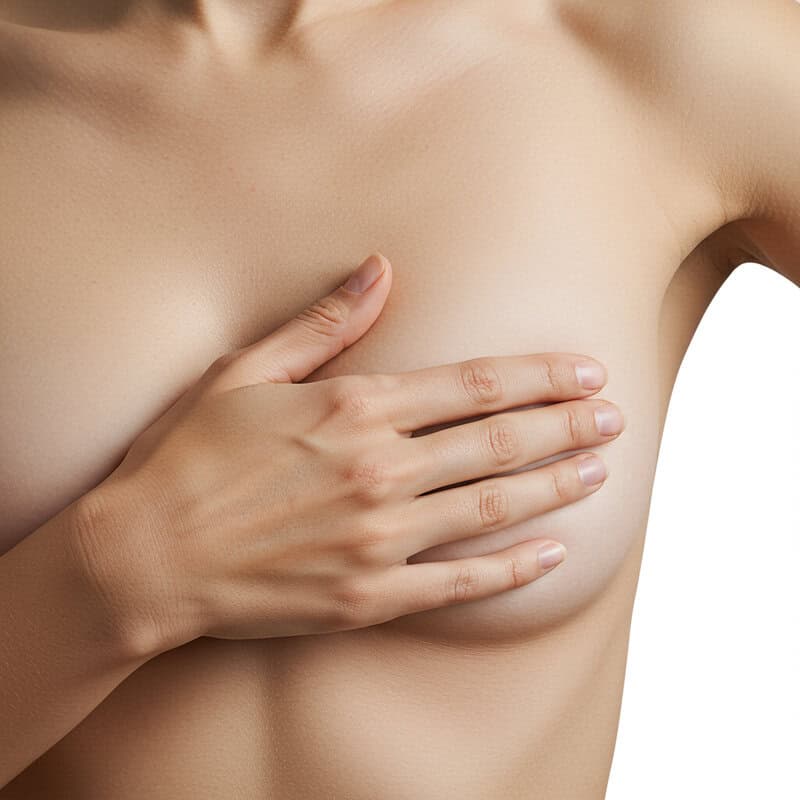
The appearance of a new lump in the breast or underarm (axilla) is often the most recognized sign associated with breast cancer. Lumps form due to abnormal cell growth, which can create masses or nodules within the breast tissue or surrounding areas. While many breast lumps are benign (non-cancerous), such as cysts or fibroadenomas, a portion can be malignant, representing early or advanced stages of cancer. According to the American Cancer Society, most breast lumps are not cancerous, but it is crucial not to ignore them. Malignant lumps tend to be painless, hard, and have irregular edges, but they can also be tender, soft, or rounded. Because it is difficult to distinguish between benign and cancerous lumps based on feel alone, any new lump or mass should be promptly evaluated by a healthcare provider. Early detection is vital for successful treatment, and even benign lumps may require monitoring or removal. If you notice a new lump, regardless of its characteristics, seeking prompt medical attention is essential for a definitive diagnosis and peace of mind.
2. Change in Breast Size or Shape
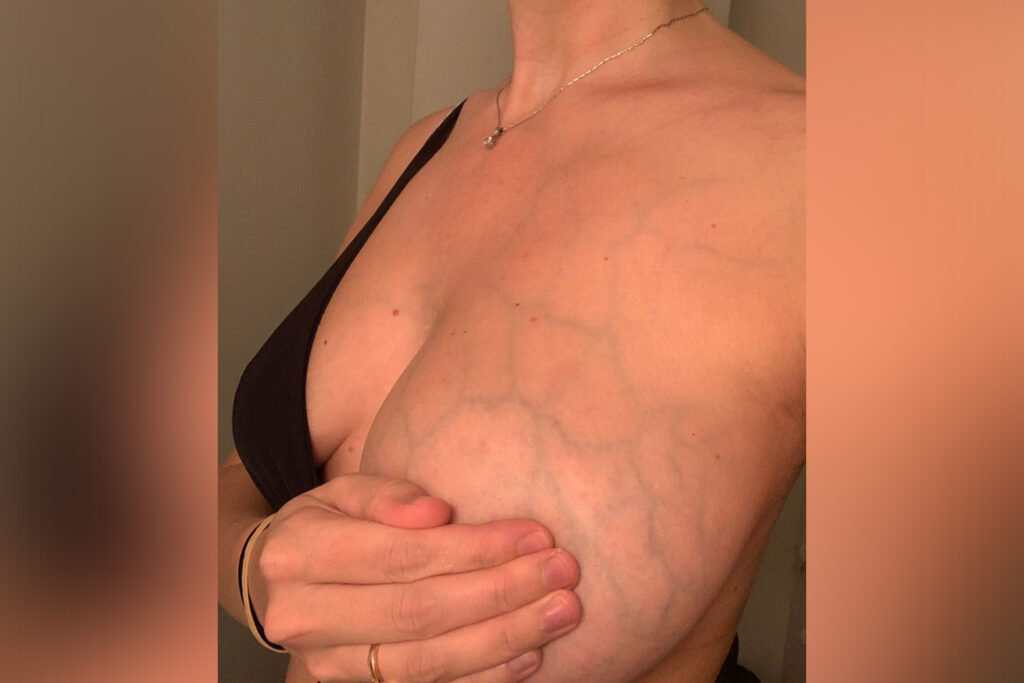
A noticeable change in the size or shape of one or both breasts can be an important indicator of underlying breast tissue changes, often resulting from tumor growth or abnormal cell activity. Tumors can distort the natural architecture of the breast, leading to swelling, enlargement, or even visible distortion. It is important to distinguish between normal and abnormal variations—natural fluctuations due to hormonal changes, pregnancy, menstruation, or weight gain are common and usually affect both breasts similarly. However, unexplained asymmetry or persistent changes that are not related to these factors may warrant concern. According to Breastcancer.org, changes such as sudden fullness, shrinkage, or noticeable bulges are potential warning signs, especially if they occur on only one side. Monitoring your breasts regularly for differences in contour, size, or overall shape is crucial for early detection. If you observe an unexplained change that does not resolve or is accompanied by other symptoms, consult a healthcare professional for evaluation. Early assessment of these changes can help identify breast cancer at a more treatable stage and rule out benign causes.
3. Dimpling or Puckering of Skin

One noticeable sign of a possible underlying breast tumor is dimpling or puckering of the skin. This occurs when a tumor grows within the breast tissue and pulls the skin inward, creating areas that look indented, wrinkled, or puckered. This appearance is sometimes described as an “orange peel” or “peau d’orange” effect due to the skin’s resemblance to the surface of an orange. Such skin changes are caused by the tumor attaching to or affecting the ligaments and connective tissue beneath the breast, which then tugs on the skin above.
While mild skin texture changes can occasionally occur due to benign causes or inflammation, persistent dimpling—especially if localized and not related to recent injury or infection—can be a red flag. According to American Cancer Society, dimpling of the breast skin should always be evaluated by a healthcare provider as it may indicate an underlying malignancy. If you notice any area of your breast taking on this dimpled, puckered, or orange peel-like texture, seek prompt medical attention for a thorough examination and appropriate diagnostic testing.
4. Nipple Discharge (Not Breast Milk)

Abnormal nipple discharge refers to any fluid that is released from the nipple outside of breastfeeding or pregnancy. While some nipple discharge can be benign and related to hormonal changes or benign growths, it can also be a sign of breast cancer, especially if it occurs without squeezing, is persistent, or is associated with other changes in the breast. Discharge associated with breast cancer may appear clear, bloody, or have a watery consistency, and is more concerning if it occurs from only one breast.
It is important to distinguish abnormal discharge from normal lactation, which typically occurs during or shortly after pregnancy. Normal lactation is usually milky and bilateral, whereas worrisome discharge often appears unexpectedly, especially in women who are not pregnant or breastfeeding. According to Breastcancer.org, discharge that is bloody, occurs spontaneously, or is accompanied by a lump or skin change should be evaluated promptly. Even though most nipple discharges are not caused by cancer, any unexplained fluid—particularly if it is persistent or unusual in color—should be checked by a healthcare provider to rule out malignancy and ensure proper treatment if needed.
5. Redness or Flaky Skin on Breast or Nipple
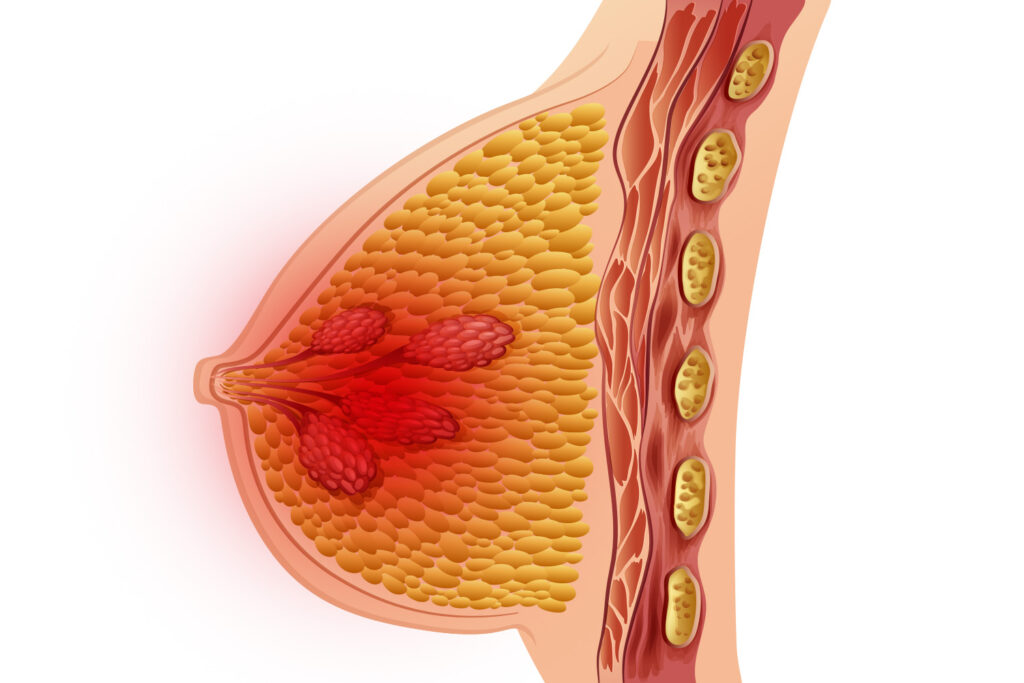
Redness or flaky skin on the breast or nipple can be a warning sign of underlying inflammation, which may be caused by certain types of breast cancer. Tumors can disrupt normal skin function, leading to irritation, scaling, or an inflamed appearance. This inflammation is sometimes seen in aggressive forms like inflammatory breast cancer, where the skin can look red, swollen, and feel warm to the touch. The affected area may also develop thickening or ridges, further altering the skin’s appearance.
These symptoms can be similar to those caused by benign conditions such as eczema or a breast infection (mastitis), especially in breastfeeding women. However, while eczema typically affects both breasts and improves with topical treatments, and infection is often accompanied by fever and pain, cancer-related changes tend to be persistent and localized. According to the American Cancer Society, persistent redness, scaling, or flaking of the nipple or breast skin should always be evaluated by a medical professional. Early assessment is crucial to distinguish between benign skin conditions and more serious causes like cancer, enabling timely and appropriate treatment.
6. Pulling in of the Nipple (Nipple Retraction)
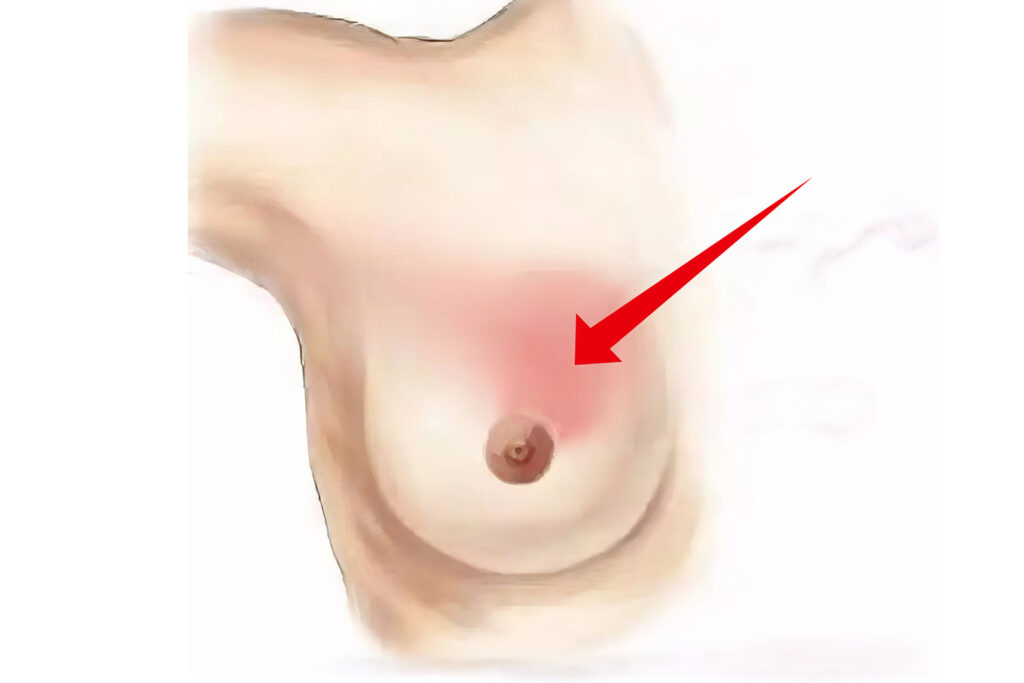
Nipple retraction occurs when the nipple turns inward or becomes pulled into the breast, which can be a significant sign of underlying breast changes. This phenomenon often happens when a tumor or abnormal tissue growth inside the breast attaches to or invades the ducts and ligaments behind the nipple. The pressure or tension from this growth pulls the nipple inward, causing it to appear flat, indented, or inverted. Unlike individuals who have naturally inverted nipples from birth—which is typically harmless and does not change over time—new or sudden nipple retraction is concerning.
It is important to monitor your breasts for any unexpected changes in the appearance or position of the nipples. According to Breastcancer.org, nipple retraction is more worrisome if it occurs suddenly and is only on one side, especially when accompanied by other symptoms such as a lump or skin changes. While benign causes like infection or inflammation can also cause temporary changes in the nipple, persistent or unexplained retraction should be promptly evaluated by a healthcare provider. Early medical assessment allows for proper diagnosis and timely intervention if needed.
7. Pain in Any Area of the Breast

Pain in the breast, known as mastalgia, can sometimes be a sign of cancer, particularly if it is localized, persistent, and not associated with the menstrual cycle. Tumors may irritate or press on nerves within the breast tissue, leading to discomfort or a dull, aching sensation in a specific area. Unlike general breast tenderness, which is common before menstruation and typically affects both breasts symmetrically, pain linked to cancer is often confined to a single spot and does not resolve with the end of the menstrual period.
It is important to note that most breast pain is not caused by cancer. Hormonal fluctuations, cysts, or benign conditions frequently result in breast discomfort. However, according to the American Cancer Society, new, unexplained breast pain—especially if it occurs in only one area or is accompanied by other changes such as a lump, redness, or nipple discharge—should not be ignored. Persistent pain should always be brought to the attention of a healthcare provider for evaluation. Early investigation helps distinguish between benign and malignant causes, ensuring timely diagnosis and management.
8. Swelling of All or Part of a Breast
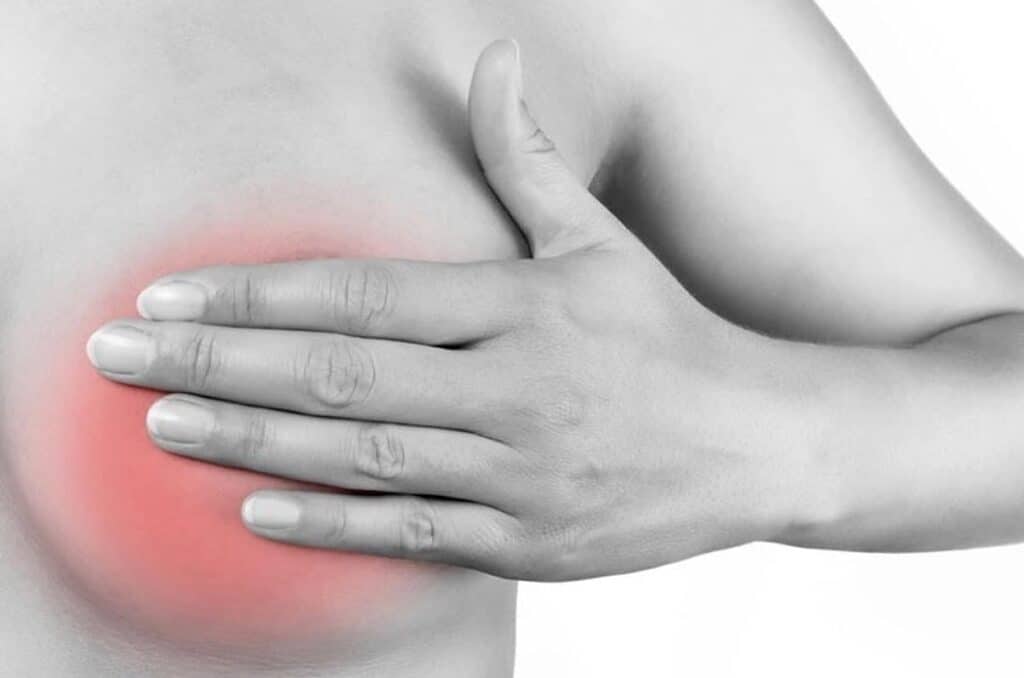
Swelling involving all or part of a breast can be a significant sign of an underlying issue, including breast cancer. This swelling may occur when a tumor blocks the normal flow of lymphatic fluid, causing fluid buildup and localized inflammation. Sometimes the swelling affects only a portion of the breast, leading to noticeable fullness, thickening, or a change in texture, while in other cases, the entire breast may appear enlarged or puffy. Tumor-related swelling can also be accompanied by redness, warmth, or tenderness, especially in aggressive forms such as inflammatory breast cancer.
It is important to differentiate this type of swelling from the generalized breast fullness commonly experienced during hormonal changes, such as before menstruation or during pregnancy. Hormonal swelling usually affects both breasts symmetrically and is temporary, resolving with the menstrual cycle or postpartum changes. According to Breastcancer.org, persistent swelling that does not improve or that affects only one breast should always be checked by a healthcare provider. Monitoring your breasts for ongoing or unexplained fullness is crucial, as early evaluation can help detect and address breast cancer or other underlying conditions promptly.
9. Swollen Lymph Nodes Under the Arm or Collarbone
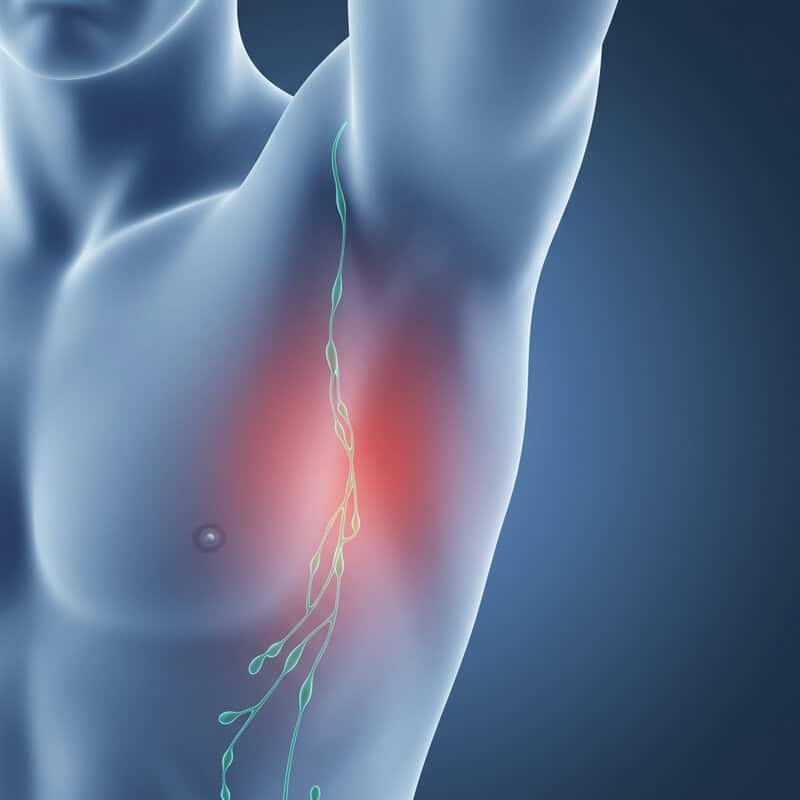
Swollen lymph nodes under the arm (axilla) or around the collarbone can be an indication that breast cancer cells have spread beyond the breast tissue. The lymphatic system acts as a drainage network for the body, and lymph nodes serve as filters, trapping abnormal cells, including cancer cells. When breast cancer spreads (metastasizes), it often first reaches these nearby lymph nodes, causing them to become enlarged, firm, or tender. These nodes may feel like small, hard lumps under the skin and are often not painful in the early stages of cancer spread.
It is important to differentiate between lymph node enlargement due to cancer and that caused by infections or inflammation, which is much more common. Swollen nodes from infection are usually tender, soft, and may be accompanied by redness or warmth in the surrounding area. According to the American Cancer Society, persistent swelling of lymph nodes—especially if not associated with a recent illness, injury, or skin infection—should be evaluated by a healthcare provider. Persistent or unexplained lymph node swelling may require further testing to rule out cancer and ensure timely intervention if needed.
10. Itchy Breast or Nipple

Persistent itchiness of the breast or nipple can sometimes be linked to underlying breast cancer, particularly rare forms such as inflammatory breast cancer or Paget’s disease of the nipple. Tumors in or near the skin may irritate nerve endings and disrupt normal skin function, resulting in ongoing itching or a burning sensation. This symptom may be accompanied by redness, scaling, or a rash-like appearance, and can sometimes be mistaken for more common benign skin conditions.
It is important to consider other possible causes of breast or nipple itchiness, such as allergic reactions, eczema, dry skin, or irritation from soaps and detergents. These conditions are typically temporary, respond well to topical treatments, and often affect both breasts. However, as noted by Breastcancer.org, persistent or worsening itchiness—especially if it is localized to one breast or nipple, or is accompanied by other skin changes—should not be ignored. If the itching does not improve with basic skincare or over-the-counter remedies, or if it is associated with additional symptoms, it is important to seek a medical evaluation to rule out cancer and obtain appropriate care.
11. Thickening of Breast Tissue
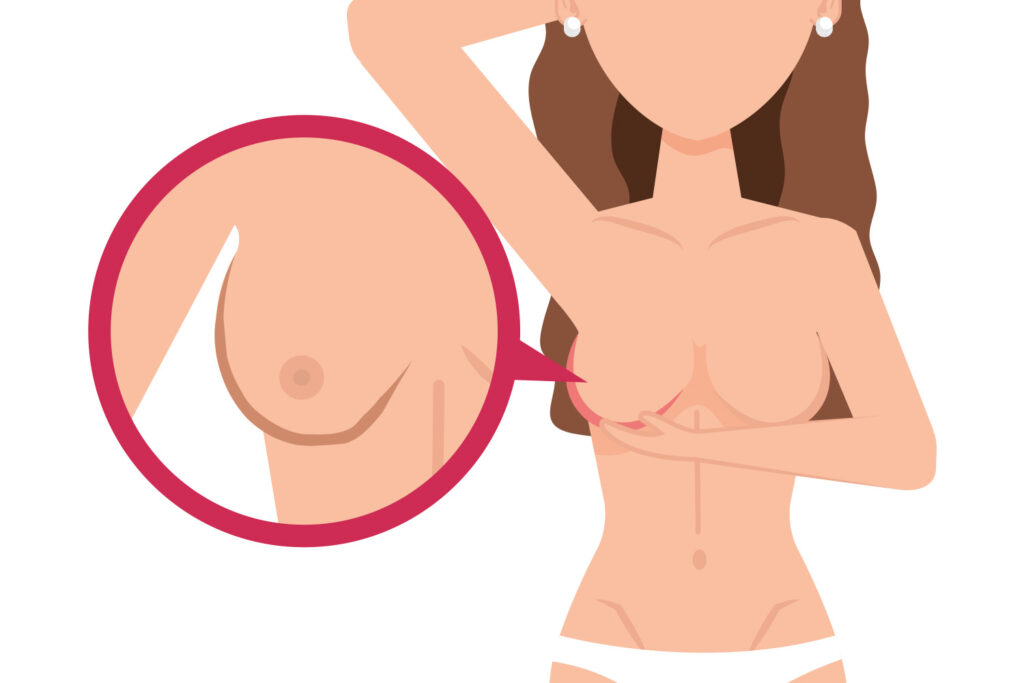
Thickening of breast tissue refers to an area that feels denser or firmer than the surrounding tissue and may be a sign of abnormal cell growth, including breast cancer. Tumor development can increase tissue density by causing fibrous or malignant cells to accumulate in one spot, making it feel noticeably different during a self-exam. This thickened area may or may not be accompanied by a distinct lump, and it often feels hard, immovable, and persistent.
Natural glandular thickening is common, particularly during hormonal changes such as menstruation, pregnancy, or breastfeeding. This benign thickening typically affects both breasts symmetrically and tends to resolve over time or with hormonal fluctuations. According to the American Cancer Society, persistent or unusual areas of thickening, especially if located in only one breast or if they do not change with your cycle, should be evaluated by a healthcare provider. Monitoring for firm, unchanging areas in the breast is crucial, as early detection of abnormal tissue density can lead to timely diagnosis and better treatment outcomes if cancer is present.
12. Sudden Visible Veins on the Breast
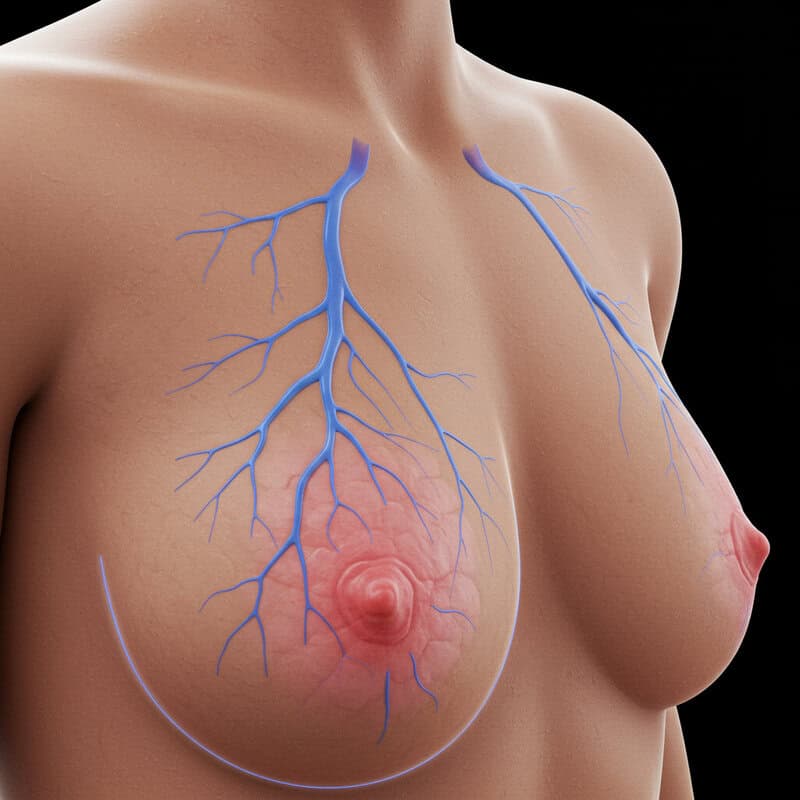
The sudden appearance of visible veins on the surface of the breast can sometimes be associated with underlying breast cancer. As a tumor grows, it may stretch the skin and underlying tissues, making the veins more prominent and noticeable. This change can result from increased blood flow required by the tumor or from swelling and pressure that alters the normal appearance of the breast. In some cases, the veins may appear bluish, engorged, or as a new network that was not previously present.
Visible veins on the breast can also be seen in benign situations, such as during pregnancy, breastfeeding, or after significant weight gain, all of which increase blood flow and skin stretching. However, as noted by Breastcancer.org, sudden and unexplained changes in the pattern or prominence of breast veins—particularly if only one breast is affected or if these changes are accompanied by swelling, redness, or a lump—should prompt a visit to a healthcare provider. Monitoring for new or unusual vein patterns is important, as this sign may indicate an underlying mass or other significant condition that requires evaluation.
13. Sore or Ulcerated Nipple
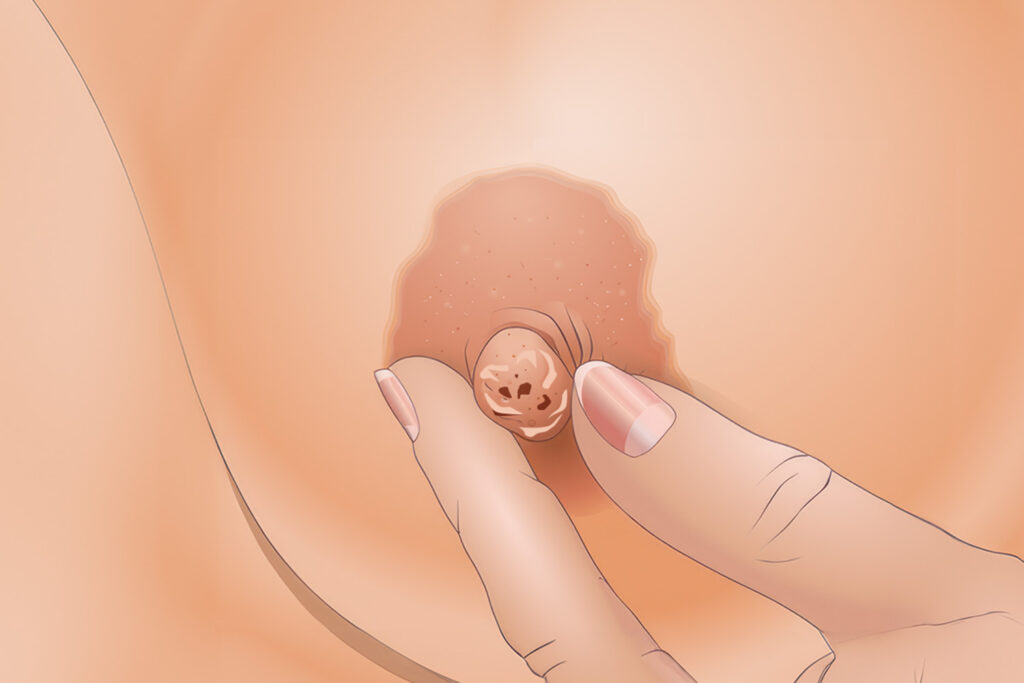
A sore or ulcerated nipple may be a sign of an underlying breast tumor, particularly when a cancerous growth invades the skin or tissue of the nipple area. Tumor invasion can lead to the breakdown of skin, resulting in open sores, persistent ulcers, or areas that do not heal. These sores may ooze, bleed, or become crusted, and are typically resistant to standard topical treatments.
It is crucial to distinguish this kind of ulceration from cracks or soreness caused by breastfeeding, which are common in nursing mothers and generally heal with proper hygiene and care. Breastfeeding-related cracks are often due to irritation, improper latch, or dry skin, and should improve as the skin recovers. Conversely, as described by the American Cancer Society, persistent sores, ulcers, or non-healing wounds on the nipple—especially when accompanied by other symptoms like discharge, thickening, or a lump—require prompt medical evaluation. Early assessment is necessary to differentiate between benign and malignant causes and to ensure appropriate treatment if cancer is present.
14. Peeling or Scaling of the Nipple
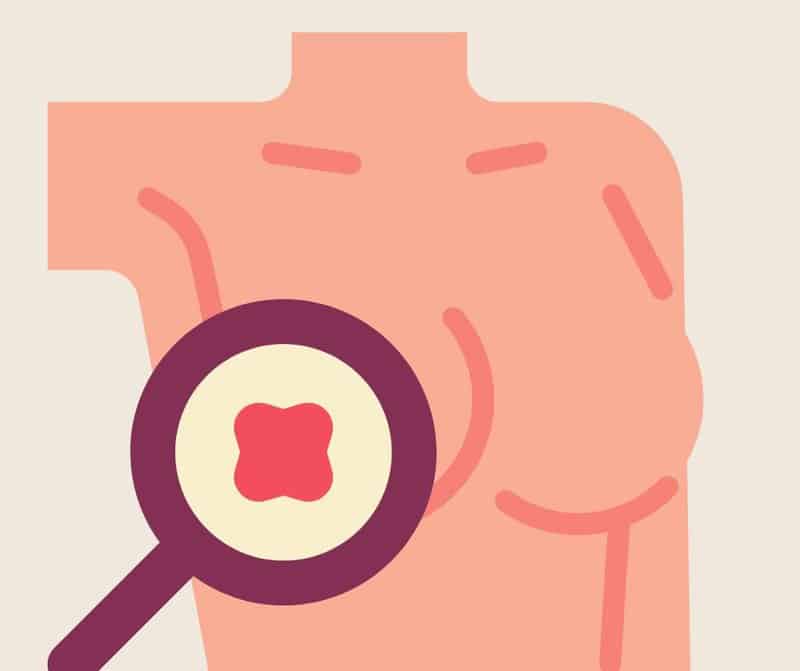
Peeling or scaling of the nipple can sometimes occur when cancer affects the skin, mimicking common dermatologic conditions. Certain forms of breast cancer, such as Paget’s disease of the nipple, can cause the skin to become dry, flaky, or scaly, and may even result in crusting or oozing. This can be accompanied by redness, irritation, or a burning sensation. These cancer-related changes may begin subtly but tend to persist and gradually worsen over time.
It is important to distinguish this symptom from eczema or dermatitis, which are benign and often respond well to moisturizers or topical steroid creams. Eczema usually affects both nipples or other areas of the body, and symptoms improve with standard treatments. In contrast, as noted by Breastcancer.org, persistent peeling or scaling that does not respond to typical skin therapies—or that affects only one nipple—should be viewed as a warning sign. If you experience ongoing flaking, peeling, or scaling of the nipple, especially when accompanied by other breast changes, a prompt evaluation by a healthcare provider is essential for accurate diagnosis and timely intervention.
15. Change in Breast Color
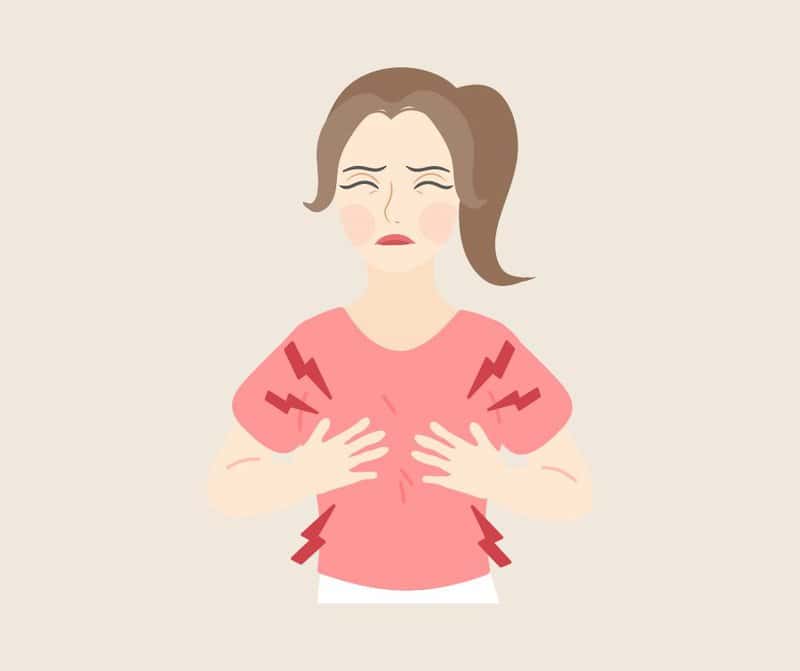
A noticeable change in the color of breast skin can be a significant indicator of underlying inflammation, which may be related to breast cancer. Some forms, such as inflammatory breast cancer, can cause the skin to appear red, purple, or even bluish, reflecting changes in blood flow, lymphatic congestion, or direct tumor involvement. This discoloration is often accompanied by other symptoms like swelling, warmth, or thickening of the skin, and may spread or worsen over time.
It is essential to differentiate cancer-related color changes from bruising, which often results from trauma and typically resolves within days to weeks with a predictable fading pattern. While bruises are usually tender and have a clear cause, discoloration linked to cancer is more persistent, not linked to injury, and may expand or deepen. According to the American Cancer Society, new or unexplained changes in breast color—especially if they continue to spread or are associated with other warning signs—should be promptly evaluated by a healthcare provider. Early assessment can help distinguish benign from serious causes and ensure timely treatment if needed.
16. Inverted Nipple

An inverted nipple refers to a nipple that turns inward instead of pointing outward. This condition can develop when underlying tissue changes, such as tumor growth, pull the nipple and surrounding structures inward. The abnormal tissue creates tension or fibrosis behind the nipple, causing it to retract toward the breast. This symptom is especially worrisome when it develops suddenly or is accompanied by other breast changes.
It is important to distinguish between a nipple that has always been inverted—a benign and natural anatomical variant—and one that has become inverted recently. Lifelong inversion typically occurs in both nipples and does not fluctuate, while a new or progressive change in nipple orientation, particularly if isolated to one breast, may signal a more serious underlying cause. According to Breastcancer.org, sudden nipple inversion, especially when associated with other symptoms such as lumps, skin changes, or discharge, should prompt immediate evaluation by a healthcare provider. Early recognition and medical assessment of nipple inversion are crucial for distinguishing harmless anatomical differences from symptoms of breast cancer and for determining the need for further testing or treatment.
17. Burning Sensation in the Breast
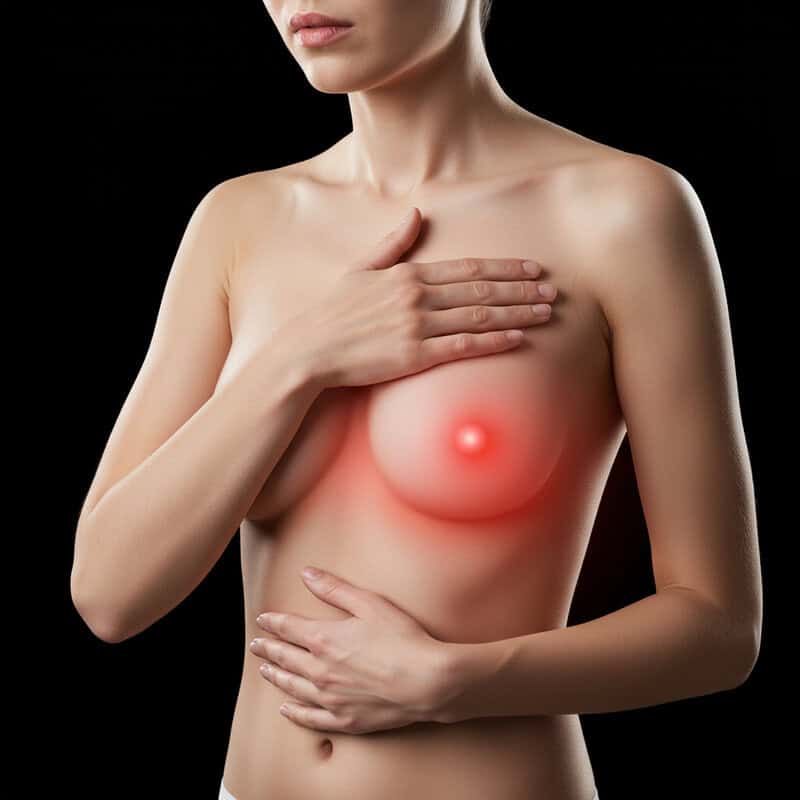
A burning sensation in the breast can sometimes occur when tumors irritate or compress nerves within the breast tissue. As a tumor grows, it may put pressure on nearby nerve endings or disrupt normal nerve pathways, leading to sensations of burning, tingling, or even numbness. This discomfort is often persistent and may be localized to a specific area of the breast, although it can sometimes radiate outward. The burning may be accompanied by other symptoms such as redness, swelling, or changes in skin texture.
Mild irritation or fleeting burning sensations in the breast are often caused by benign issues such as mild skin irritation, friction from clothing, or hormonal changes. These sensations are usually temporary and resolve without intervention. However, as noted by the American Cancer Society, new or persistent burning sensations that do not improve, especially if accompanied by other warning signs, should not be ignored. If you experience an unexplained burning feeling in your breast that lingers or worsens, it is important to seek a medical evaluation to determine the cause and ensure prompt treatment if necessary.
18. Persistent Breast Warmth
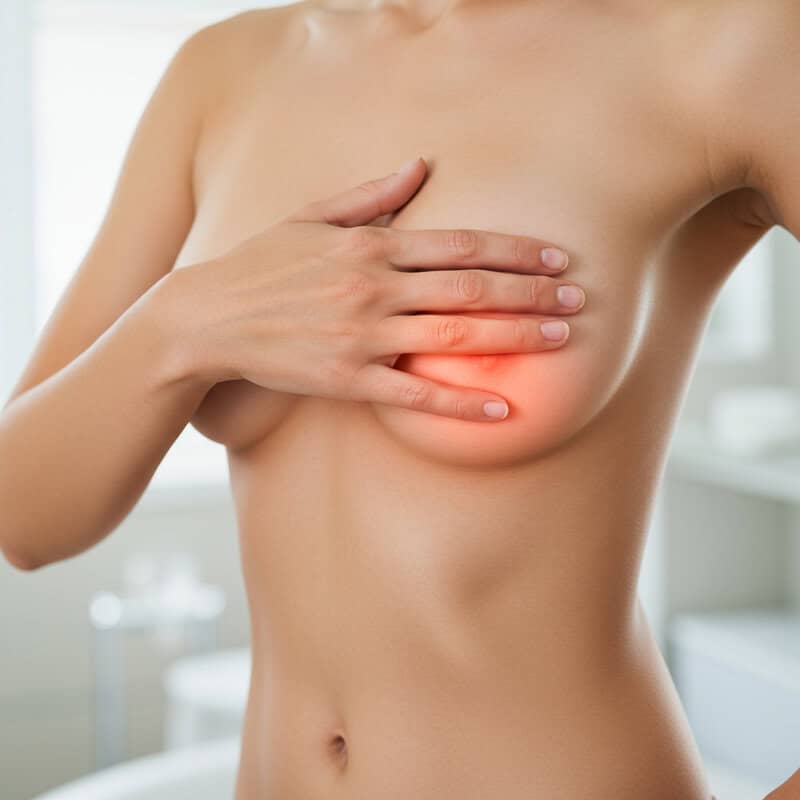
Persistent warmth in the breast can be a sign of inflammation within the breast tissue, which may be caused by aggressive forms of breast cancer such as inflammatory breast cancer. Tumors and associated inflammation increase blood flow to the area, making the skin and underlying tissue feel unusually warm or hot to the touch. This persistent heat sensation may also be accompanied by redness, swelling, or changes in skin texture, and typically does not resolve on its own.
It is important to differentiate this type of warmth from warmth caused by infection, such as mastitis, which is more common in breastfeeding women. Infections usually present suddenly and are often associated with pain, fever, and sometimes pus or discharge. Infection-related warmth generally improves with antibiotics or other medical treatment. However, according to American Cancer Society, persistent warmth that does not improve, especially if it is not linked to infection or is associated with other symptoms like swelling or skin changes, should be evaluated by a healthcare provider. Early assessment is crucial for accurate diagnosis and appropriate management.
19. Hardening or Firmness of the Breast
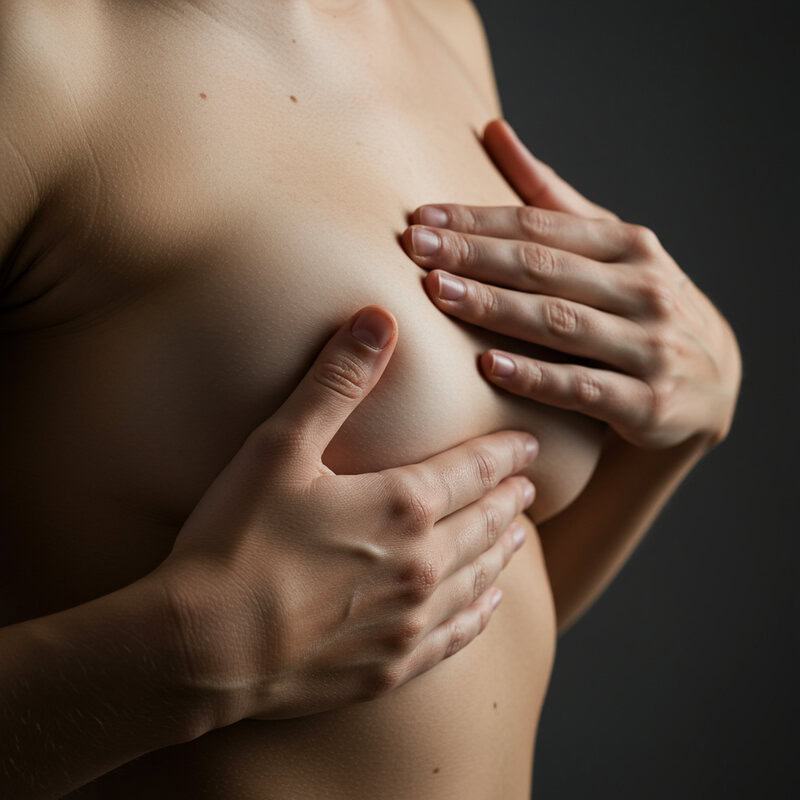
Hardening or unusual firmness of the breast can be an important sign of underlying tumor growth. As abnormal cells accumulate and form a mass, the affected area of the breast may feel distinctly harder or firmer than the surrounding tissue. This change in texture is caused by both the physical presence of a tumor and the body’s response, which can include fibrosis (increased connective tissue) around the abnormal growth. The firmness may be localized to one part of the breast or, in some cases, affect a larger area.
It is essential to distinguish this pathological firmness from the cyclical changes that commonly occur during a woman’s menstrual cycle. Hormonal fluctuations can cause temporary swelling and firmness in both breasts, which typically resolves after menstruation. According to American Cancer Society, new or persistent hardening—especially if it is confined to a specific area, does not fluctuate with your cycle, or is accompanied by other symptoms such as a lump or skin changes—should be evaluated by a healthcare provider. Prompt evaluation can help identify cancer or other serious conditions early, improving treatment outcomes.
20. Unexplained Bruising on the Breast
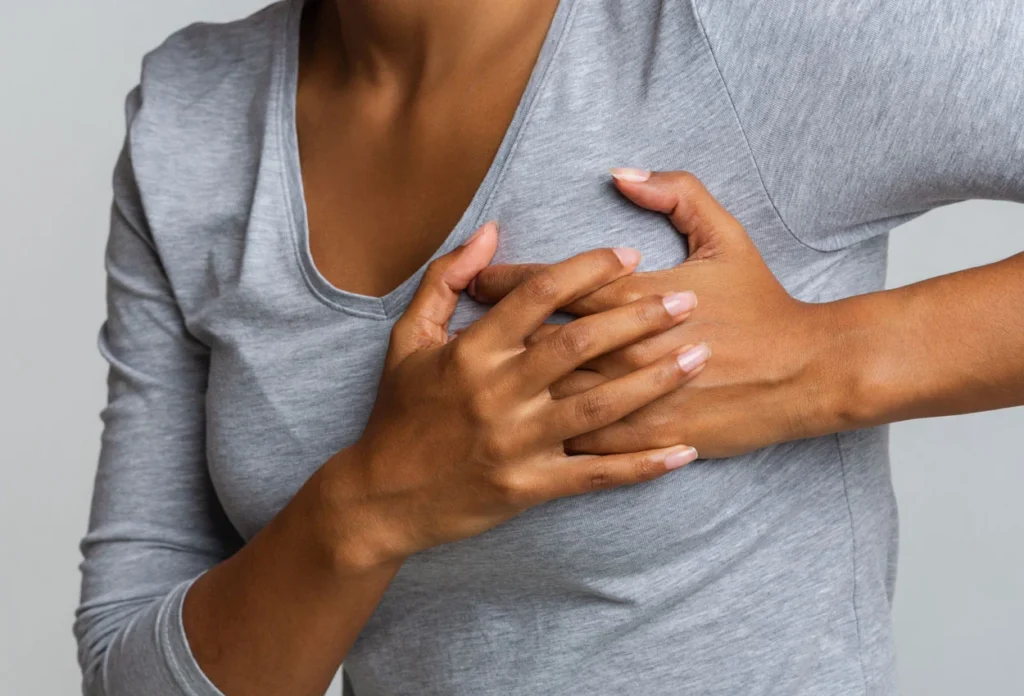
Unexplained bruising on the breast can be a concerning sign and may indicate that underlying cancer is damaging blood vessels or affecting tissue integrity. Tumor growth can invade or compress small blood vessels beneath the skin, leading to leakage of blood and the appearance of bruises or discoloration. This bruising may appear as purple, blue, or brown patches and often arises without any clear cause, such as injury or trauma. In some cases, the bruising may spread or fail to heal normally, raising further concern.
Accidental bruises are common and usually have a known cause, such as a bump or fall. These bruises typically resolve within a week or two, fading gradually as the body reabsorbs the blood. However, as noted by the Breastcancer.org, bruising that appears spontaneously, does not improve, or is accompanied by other symptoms—like swelling, pain, or changes in the skin—should be evaluated by a healthcare provider. Unexplained or persistent bruising may signal a more serious underlying problem, such as breast cancer, and prompt medical attention is essential for accurate diagnosis and timely intervention.
21. Nipple Pain
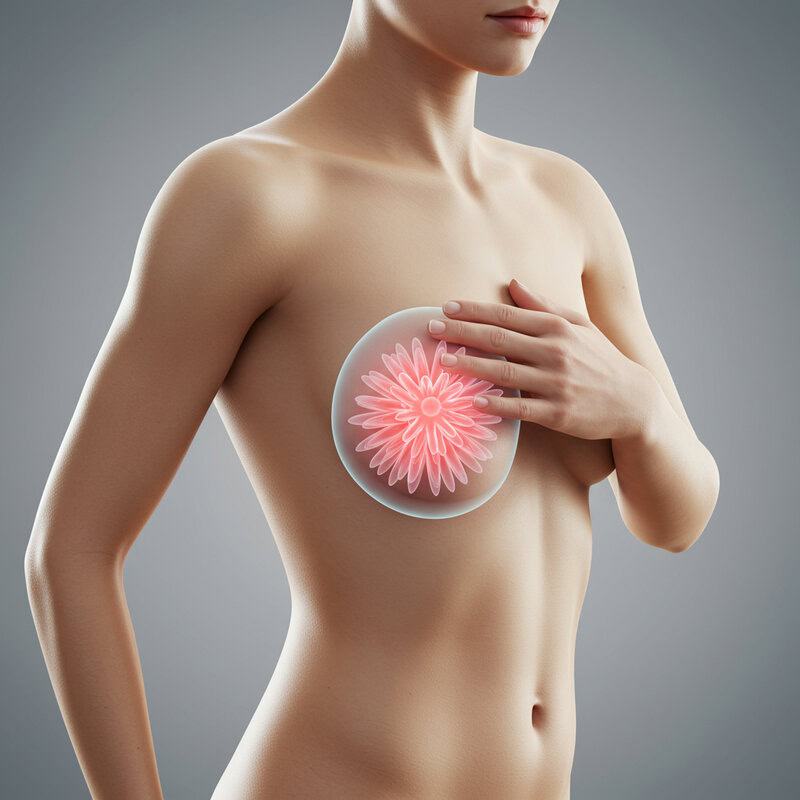
Nipple pain can be a symptom of breast cancer, particularly when caused by tumor growth or localized inflammation affecting the sensitive nerve endings in the nipple area. As a tumor develops, it may compress or irritate these nerves, resulting in discomfort, sharp pain, or a persistent aching sensation. Inflammatory processes linked to cancer can also lead to swelling and tenderness in and around the nipple, intensifying the pain and sometimes causing other changes such as redness or thickening of the skin.
It is important to distinguish cancer-related nipple pain from sensitivity or discomfort due to other, more common causes. Hormonal fluctuations during menstruation, pregnancy, breastfeeding, or even irritation from tight clothing can all result in temporary nipple sensitivity or soreness. These benign causes typically resolve on their own or with simple lifestyle adjustments. However, as highlighted by the American Cancer Society, persistent, unexplained nipple pain that does not improve or is associated with additional symptoms—such as discharge, changes in appearance, or a lump—should not be ignored. Seeking medical evaluation ensures early diagnosis and appropriate care if cancer or another serious condition is present.
22. Nipple Sores That Won’t Heal

Non-healing sores on the nipple are a potential sign of an underlying disease process, including breast cancer. Tumor cells can disrupt the normal healing process by invading the skin and surrounding tissues, leading to chronic open wounds or ulcers that persist for weeks or months. These sores may be painful, bleed, ooze, or develop a crusted surface, and they typically resist standard treatments such as antibiotics or topical creams.
In contrast, common sores or minor abrasions from irritation, friction, or breastfeeding usually heal within a few days to a couple of weeks when properly cared for. Benign lesions tend to improve steadily over time and do not recur in the same spot. According to American Cancer Society, the presence of a chronic sore or ulcer on the nipple that does not heal should be taken seriously. Chronic lesions are a warning sign and warrant prompt evaluation by a healthcare provider to determine the cause, rule out malignancy, and initiate timely treatment if necessary.
23. Skin Thickening or Redness, Especially if Spreading
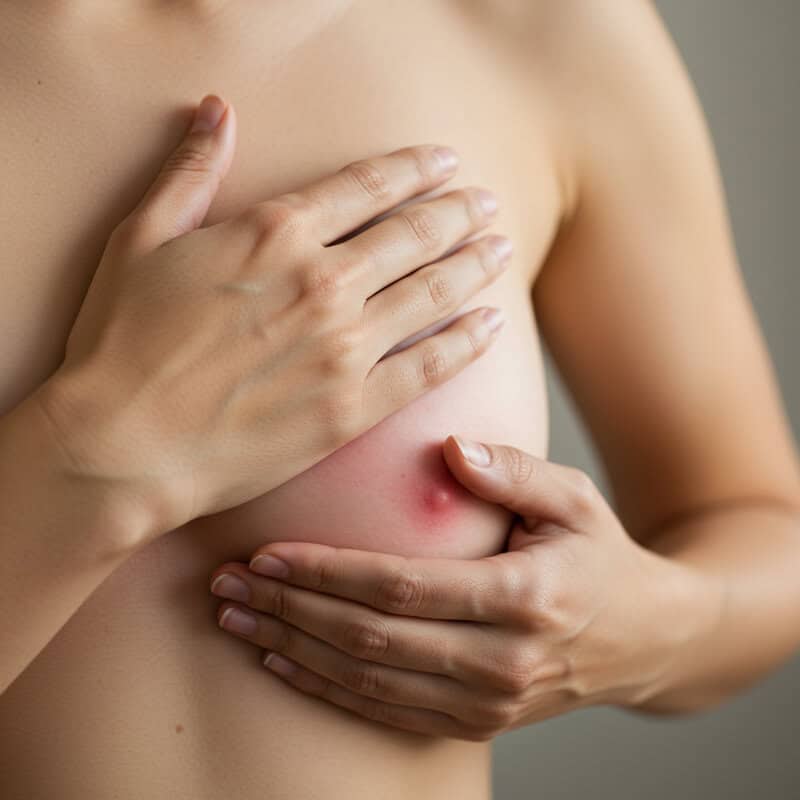
Skin thickening or redness of the breast, particularly when it spreads quickly, can be a hallmark of aggressive cancers such as inflammatory breast cancer. This type of cancer causes swelling, inflammation, and rapid changes to the skin’s texture, making it appear thickened, pitted, or swollen. The redness often feels warm to the touch and can spread over a significant portion of the breast within a short period. These changes result from cancer cells blocking lymphatic vessels in the skin, leading to fluid buildup and irritation.
It is important to differentiate these symptoms from those of a mild rash or skin irritation, which are usually limited in scope, respond to topical treatments, and resolve within a few days. Mild rashes are rarely associated with underlying lumps or persistent swelling. According to the American Cancer Society, rapidly spreading redness or thickening of the breast skin should be considered urgent and requires immediate medical evaluation. Early intervention is crucial for aggressive cancers, as they can advance quickly and may require specialized treatment. Persistent or spreading changes in skin texture or color should never be ignored.
24. Swelling in One Arm
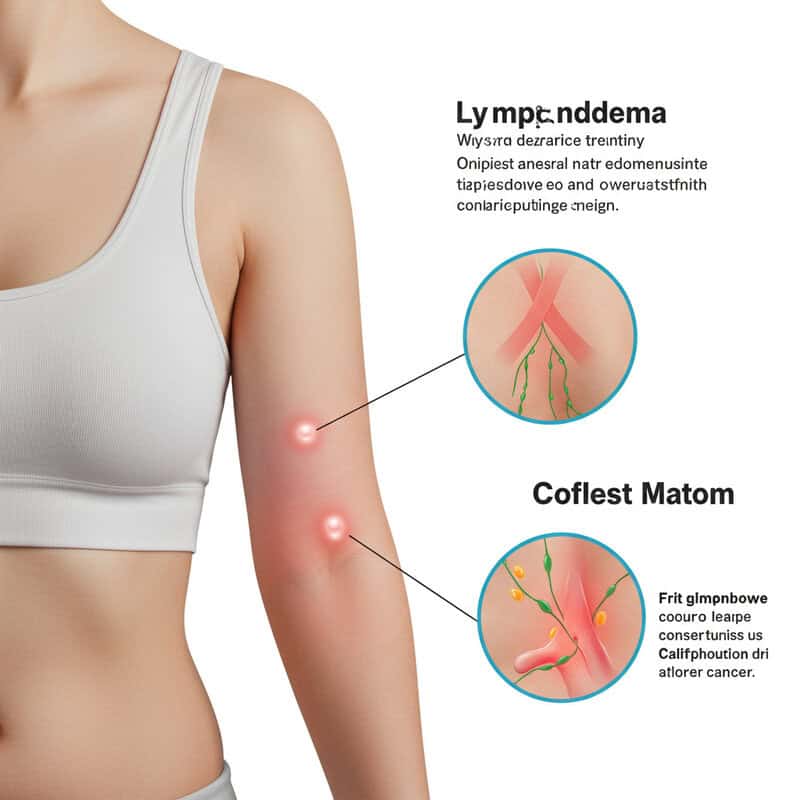
Swelling in one arm, particularly on the same side as a breast abnormality, can be a sign of lymphatic blockage caused by breast cancer. When cancer cells invade or compress the lymph nodes under the arm or near the collarbone, they can disrupt the normal drainage of lymphatic fluid from the arm. This blockage leads to a buildup of fluid, known as lymphedema, resulting in visible swelling, heaviness, or a tight sensation in the affected arm. Over time, the swelling can become uncomfortable and may limit movement or function.
Swelling in one arm can also result from injury, infection, or overuse, and in these cases, it is usually temporary and improves with rest, elevation, or basic medical care. However, according to the American Cancer Society, persistent or unexplained swelling in one arm—especially if accompanied by other breast changes or a history of breast cancer—should be evaluated promptly by a healthcare provider. Early identification and treatment of lymphedema or its underlying causes are crucial for preventing complications and ensuring the best possible outcomes.
25. Peau d’Orange (Orange Peel Texture)

Peau d’orange, a French term meaning “orange peel,” describes a distinctive skin texture that resembles the dimpled surface of an orange. This classic sign is often associated with inflammatory breast cancer and results from lymphatic obstruction beneath the skin. When cancer cells block the small lymphatic vessels, fluid accumulates in the tissue, causing swelling and pulling on the hair follicles. The skin becomes pitted, thickened, and may appear slightly shiny or taut, giving it a characteristic bumpy or dimpled appearance.
This texture change is highly significant and differs from ordinary skin roughness or mild swelling due to benign causes. According to the American Cancer Society, the presence of peau d’orange is a red flag for aggressive breast cancer and warrants immediate evaluation. The orange peel effect may develop rapidly and can be accompanied by redness, warmth, or tenderness. If you notice this change in the skin of your breast, it is essential to seek prompt medical attention to determine the underlying cause and begin appropriate treatment as soon as possible.
26. Rapid Breast Enlargement

Rapid enlargement of the breast is a concerning symptom that can result from the presence of aggressive tumors, such as inflammatory breast cancer. These fast-growing cancers can cause the breast to increase in size noticeably over a short period, sometimes within days to weeks. The enlargement is often accompanied by other symptoms, including redness, warmth, pain, or changes in skin texture. Tumor growth or swelling from blocked lymphatic drainage contributes to this sudden change in breast size.
In contrast, gradual changes in breast size are commonly related to hormonal fluctuations, pregnancy, or weight gain and typically occur over months or years. These benign changes usually affect both breasts symmetrically and are not associated with other alarming symptoms. According to the American Cancer Society, rapid and unexplained enlargement of one breast, especially if accompanied by skin changes or discomfort, should be investigated urgently. Prompt medical evaluation is vital for identifying aggressive cancers early and initiating appropriate treatment to improve outcomes and reduce the risk of complications.
27. Loss of Sensation in the Breast or Nipple
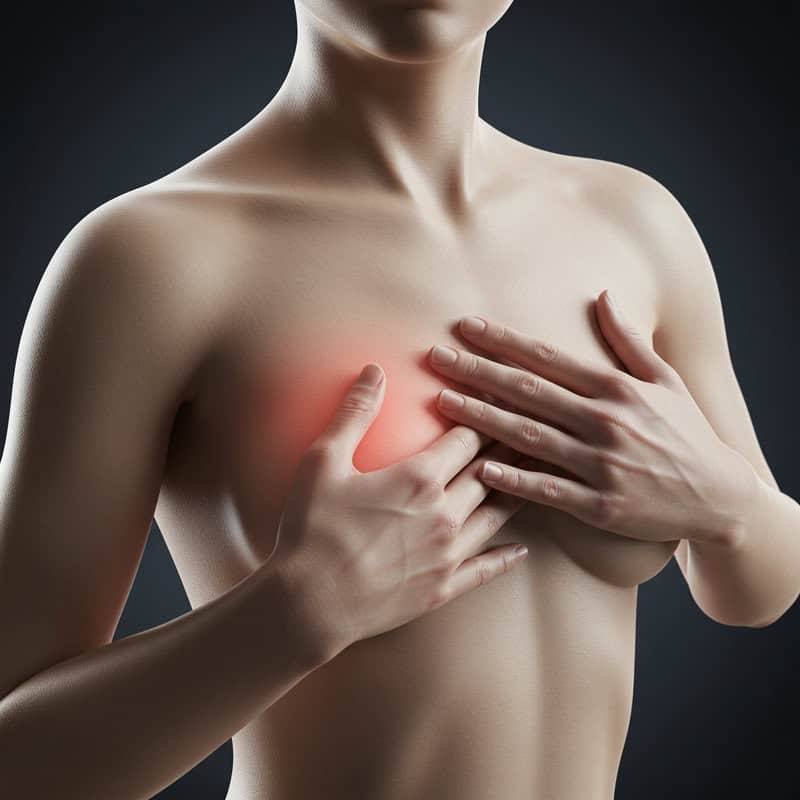
Loss of sensation in the breast or nipple can occur when tumors involve or compress the nerves that serve these areas. As a tumor grows, it may disrupt normal nerve function either by direct invasion or by creating pressure on nerve pathways, leading to numbness, tingling, or a complete loss of feeling. This change in sensation may be subtle at first but can become more pronounced as the disease progresses, sometimes affecting only a localized area or, less commonly, the entire breast or nipple.
Numbness or loss of sensation can also result from minor injuries, such as a blow to the chest or irritation from tight clothing, but these causes are typically short-lived and resolve with rest and time. Persistent or unexplained numbness, especially if it develops alongside other symptoms such as lumps, skin changes, or discharge, can indicate a more serious underlying problem. According to the American Cancer Society, any new or ongoing loss of sensation in the breast or nipple should prompt prompt medical evaluation to determine the cause and allow for early intervention if breast cancer or another serious condition is present.
28. Breast Skin Ulceration
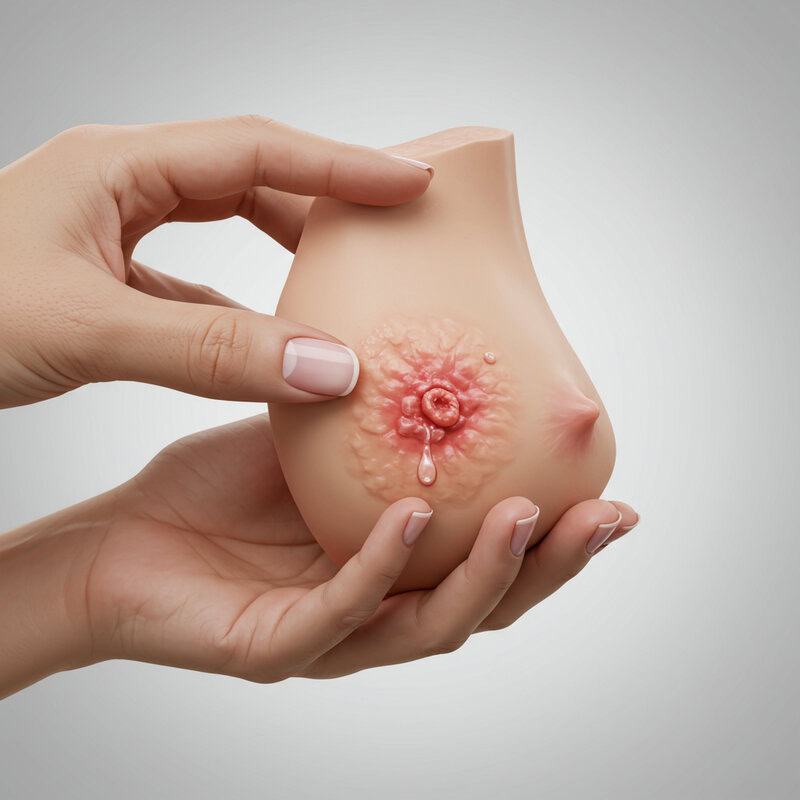
Breast skin ulceration refers to the development of open sores or wounds on the breast surface, often resulting from advanced tumors breaking through the skin. As a tumor grows and invades deeper layers of tissue, it can compromise the skin’s integrity, leading to persistent ulcers that do not heal. These ulcers may appear as raw, weeping, or bleeding areas, and are typically resistant to standard wound care or topical treatments. Ulceration is a serious sign, indicating that the cancer has reached an advanced stage and is affecting the skin directly.
Simple sores or superficial abrasions from minor injuries, friction, or irritation generally heal within a short period with basic care and are not associated with underlying masses or significant skin changes. In contrast, as noted by the American Cancer Society, any persistent or progressive ulceration of the breast skin demands immediate medical attention. Early intervention is critical to manage complications, prevent infection, and determine the appropriate treatment plan. If you notice an ulcer that does not heal or worsens over time, seek prompt evaluation by a healthcare provider.
29. Unexplained Weight Loss

Unexplained weight loss can be a systemic sign of breast cancer, particularly in more advanced stages. Cancer can increase the body’s metabolic demands, disrupt normal hormone levels, and produce substances that suppress appetite or interfere with nutrient absorption. These systemic effects may lead to significant, unintentional weight loss even when dietary habits remain unchanged. Weight loss associated with cancer is often accompanied by fatigue, weakness, and a general decline in overall health.
In contrast, weight loss resulting from intentional changes in diet, exercise, or lifestyle is usually predictable and gradual, with a clear cause and no associated alarming symptoms. Healthy weight loss is not generally accompanied by persistent fatigue or other unexplained physical changes. According to the American Cancer Society, unexplained weight loss of 10 pounds or more, especially when accompanied by other symptoms such as breast changes, pain, or lumps, should be promptly evaluated by a healthcare provider. Early assessment can help identify underlying diseases, including breast cancer, and ensure timely and appropriate management for the best possible outcomes.
30. Fatigue or Unusual Tiredness

Persistent fatigue or unusual tiredness can be a symptom of breast cancer, especially as the disease progresses or becomes more systemic. Cancer can produce substances that interfere with normal cell function and energy metabolism, leading to a constant feeling of exhaustion that does not improve with rest or adequate sleep. The body’s response to fighting cancer, along with potential anemia or nutritional deficiencies, can further contribute to profound fatigue, making even simple daily activities feel overwhelming.
It is important to differentiate cancer-related fatigue from tiredness experienced in daily life due to stress, overwork, lack of sleep, or other lifestyle factors. Everyday tiredness is typically temporary and improves with rest, relaxation, or changes in routine. In contrast, cancer-related fatigue is persistent, often worsening over time, and is not relieved by normal rest. According to the American Cancer Society, ongoing unexplained fatigue—particularly when accompanied by other warning signs such as breast lumps, unexplained pain, or weight loss—should be evaluated by a healthcare provider. Early investigation can help identify underlying causes, including breast cancer, and guide timely treatment.
31. Loss of Appetite

Loss of appetite, also known as anorexia, can occur as a result of breast cancer or as a side effect of cancer treatments. Tumors may produce chemicals that disrupt normal hunger signals, alter taste and smell, or cause inflammation in the digestive tract, making food less appealing. As cancer progresses, the body’s increased metabolic demands and emotional stress can further suppress appetite. Treatments such as chemotherapy, radiation, and certain medications may also contribute to nausea, changes in taste, or mouth sores, all of which can reduce the desire to eat.
It is important to distinguish cancer-related appetite loss from temporary changes due to stress, anxiety, minor illness, or lifestyle adjustments, which usually resolve once the underlying issue is addressed. According to the American Cancer Society, persistent or unexplained loss of appetite—especially if associated with weight loss, fatigue, or other symptoms—should be reported to a healthcare provider. Early intervention is essential to address nutritional deficits, maintain strength, and identify any underlying medical conditions, including breast cancer, that may be contributing to this symptom.
32. Unexplained Fever or Night Sweats

Unexplained fever or night sweats can be a sign of a systemic illness, including breast cancer. As cancer progresses or spreads, it can trigger the immune system to release chemicals called cytokines, which raise the body’s temperature and result in persistent low-grade fevers or episodes of drenching night sweats. These symptoms may occur without any obvious infection and are often accompanied by fatigue, weight loss, or other general symptoms. In advanced cases, fever may also signal that the cancer has affected multiple organs or that there is an associated secondary infection.
Fever and night sweats are more commonly the result of infections, such as the flu, a common cold, or other bacterial or viral illnesses. These fevers usually have a clear cause, resolve with treatment, and are often accompanied by acute symptoms like sore throat or cough. According to the American Cancer Society, persistent or unexplained fever and night sweats—particularly if unrelated to obvious infection or if associated with other symptoms such as lumps, fatigue, or weight loss—require prompt medical evaluation. Early investigation can help identify underlying causes and guide necessary treatment.
33. Back or Shoulder Pain
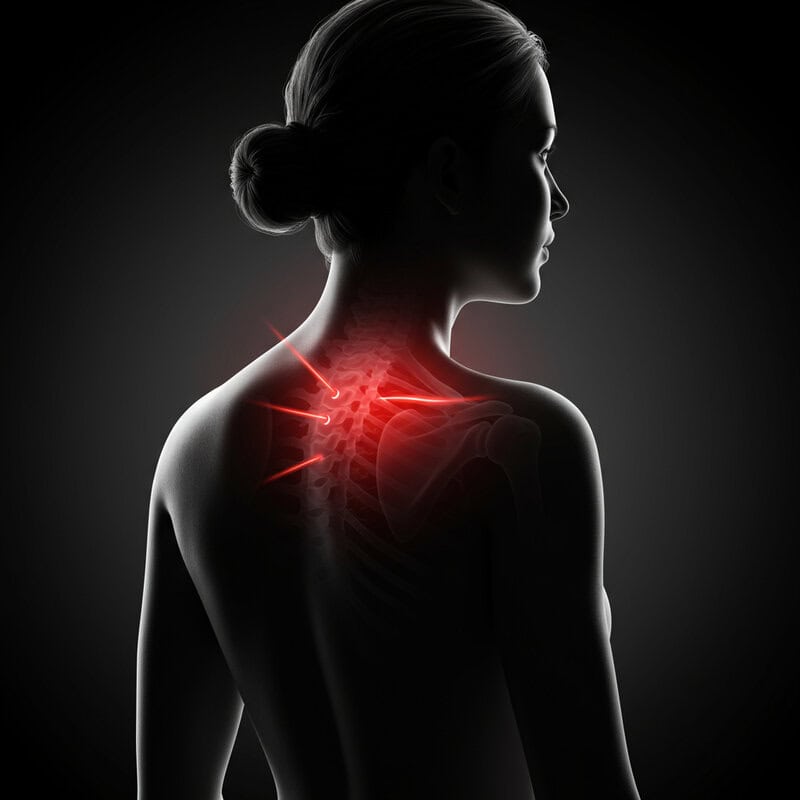
Back or shoulder pain can sometimes be a symptom of breast cancer, particularly when tumors grow near the chest wall or spread to nearby structures. This pain may be referred, meaning that it originates in the breast but is felt in the back, shoulder, or even the upper arm. Tumors can irritate nerves or infiltrate surrounding tissues, causing persistent, localized discomfort that does not improve with rest or typical pain relief methods. In advanced cases, breast cancer may spread (metastasize) to the bones of the spine or shoulders, resulting in chronic pain that may worsen over time.
Muscle soreness or strain from physical activity, poor posture, or minor injuries is much more common and generally resolves with rest, stretching, or over-the-counter medications. These benign causes of pain are usually linked to a specific activity or event and improve within a few days. According to the American Cancer Society, persistent or unexplained back or shoulder pain—especially if accompanied by other breast symptoms or not associated with an obvious cause—should be evaluated by a healthcare provider to rule out serious underlying conditions, including breast cancer.
34. Chest Wall Pain
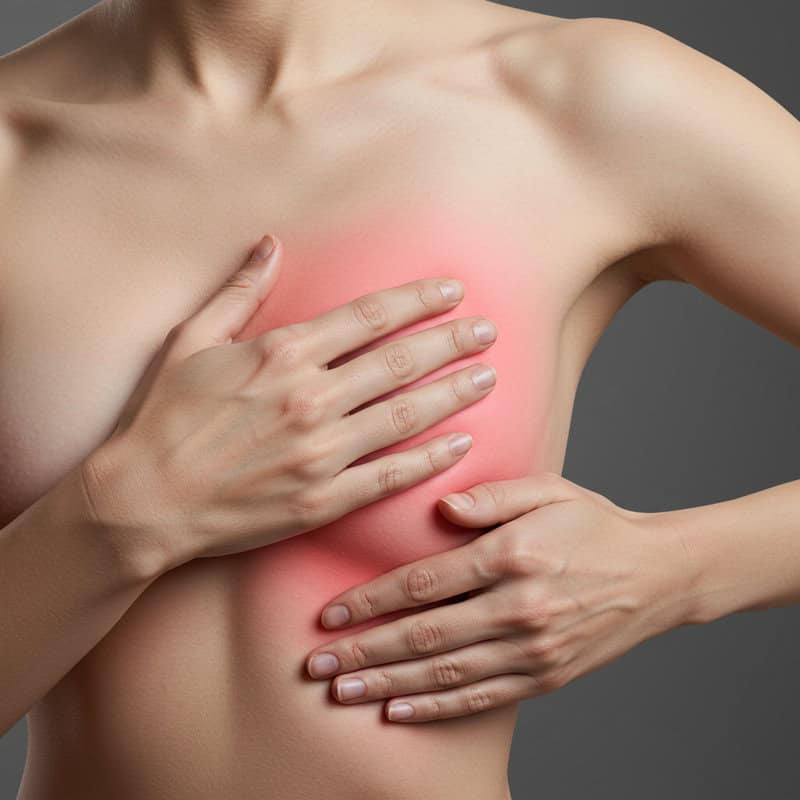
Chest wall pain can be a sign of breast cancer when a tumor invades the tissues of the chest wall, including muscles, ribs, or connective tissue. As the tumor grows, it can cause persistent, localized pain or discomfort that may be dull, aching, or even sharp. This type of pain is often continuous and does not improve with changes in position or routine pain relief measures. In some cases, the pain may be accompanied by swelling, redness, or a visible lump, indicating deeper tissue involvement.
Chest wall pain is more commonly caused by benign conditions like costochondritis—inflammation of the cartilage that connects the ribs to the breastbone. Costochondritis typically produces tenderness at the front of the chest and improves with anti-inflammatory medications or rest. It often follows physical strain or respiratory infections and is not usually associated with other breast changes. According to the American Cancer Society, any new, persistent, or unexplained chest wall pain—especially if accompanied by other warning signs—should be promptly evaluated by a healthcare provider. Early assessment can help distinguish between benign and serious causes, including breast cancer.
35. Persistent Cough or Shortness of Breath

Persistent cough or shortness of breath can be signs that breast cancer has advanced and spread (metastasized) to the lungs. When cancer cells reach the lungs, they may cause irritation, inflammation, or fluid buildup (pleural effusion), leading to ongoing cough, wheezing, or difficulty breathing. These symptoms tend to be chronic and may worsen over time, sometimes accompanied by chest discomfort, fatigue, or unexplained weight loss. In some cases, the cough may produce blood-tinged sputum or be associated with recurrent respiratory infections.
Most coughs and episodes of shortness of breath are caused by benign conditions such as seasonal allergies, the common cold, or mild respiratory infections. These symptoms usually resolve within a few days to a couple of weeks and are often accompanied by other typical signs of infection, such as fever or sore throat. According to the American Cancer Society, persistent or unexplained respiratory symptoms—especially when not linked to illness or when accompanied by other signs of breast cancer—should be evaluated by a healthcare provider. Early assessment is crucial to determine the underlying cause and to initiate prompt, appropriate treatment if needed.
36. Bone Pain
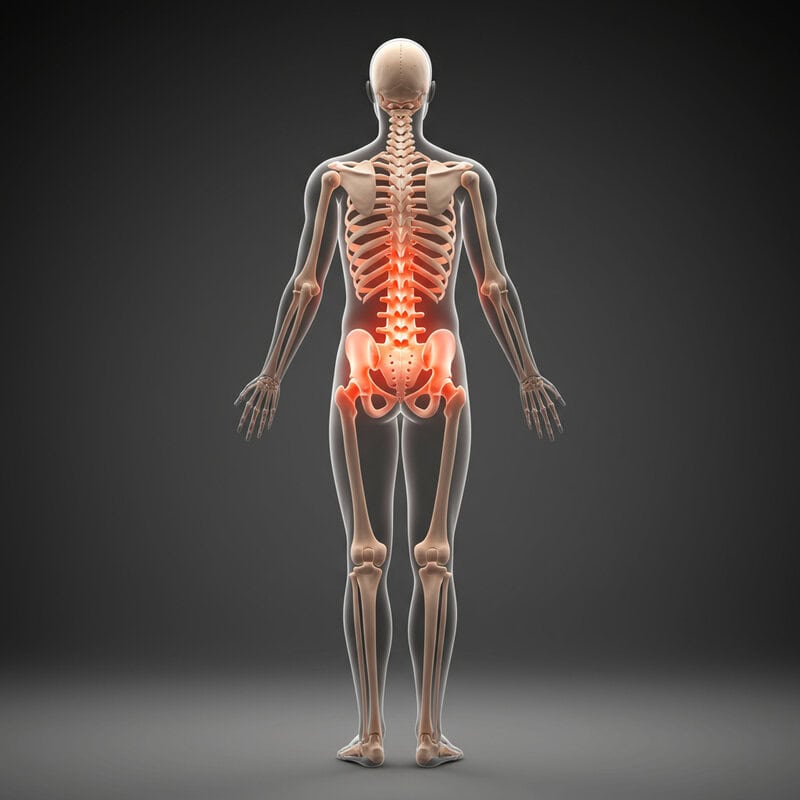
Bone pain can be a significant symptom of advanced breast cancer, indicating that the cancer has metastasized (spread) to the bones. Common sites for breast cancer metastasis include the spine, hips, pelvis, and long bones of the arms and legs. When cancer invades bone tissue, it can cause persistent, deep, or aching pain that may worsen at night or with movement. This pain is often unrelenting and does not respond well to typical pain relief measures. In severe cases, metastasis may also weaken the bone structure, increasing the risk of fractures or breaks from minor injuries.
In contrast, most joint and bone pain in everyday life is related to benign conditions such as arthritis, overuse, or minor injuries. These common aches usually fluctuate, improve with rest, or respond to over-the-counter medications. According to the American Cancer Society, persistent or unexplained bone pain—especially if accompanied by other symptoms of breast cancer or a history of malignancy—should be evaluated by a healthcare provider. Early recognition of bone involvement can lead to timely treatment and help prevent complications such as fractures or loss of mobility.
37. Yellowing of Skin or Eyes (Jaundice)

Yellowing of the skin or eyes, known as jaundice, can be a sign that breast cancer has metastasized to the liver. When cancer cells invade the liver, they can impair its ability to process and eliminate bilirubin—a yellow pigment produced during the breakdown of red blood cells. The buildup of bilirubin in the bloodstream causes the characteristic yellow discoloration of the skin and the whites of the eyes. Jaundice from liver metastasis may also be accompanied by other symptoms such as dark urine, pale stools, abdominal pain, or unexplained weight loss.
Jaundice can also occur due to other conditions such as hepatitis, gallstones, or other liver diseases. Jaundice from hepatitis is often associated with symptoms of infection, such as fever, fatigue, and nausea, and is usually identified through blood tests that detect liver inflammation. According to the American Cancer Society, any new, unexplained yellowing of the skin or eyes should be evaluated promptly by a healthcare provider. Early investigation is crucial to determine the underlying cause and begin appropriate treatment, especially if cancer is suspected.
38. Unusual Headaches

Unusual or persistent headaches can be a sign of rare but serious breast cancer metastasis to the brain. When breast cancer cells spread to the brain, they can cause increased pressure within the skull or directly irritate brain tissue, leading to severe, new, or progressively worsening headaches. These headaches may be accompanied by other neurological symptoms such as vision changes, nausea, vomiting, difficulty speaking, weakness, or seizures. The pain may be constant, more severe in the morning, or worsen with coughing or bending over.
Most headaches are due to benign causes like tension, stress, dehydration, or sinus issues. Tension headaches typically present as a mild to moderate, band-like pressure around the head and often resolve with rest, hydration, or over-the-counter medication. According to the American Cancer Society, any new, severe, or unusual headache—especially if it is different from previous headaches, persistent, or accompanied by neurological symptoms—should prompt immediate medical evaluation. Early detection of brain metastasis can lead to timely treatment and prevent potentially life-threatening complications.
39. Visual Changes

Visual changes, such as blurred vision, double vision, or sudden vision loss, can occur in rare cases when breast cancer metastasizes to the brain or the tissues surrounding the eyes. Tumor growth in these areas can exert pressure on the optic nerves or other structures involved in vision, leading to noticeable changes in sight. These symptoms may also be accompanied by headaches, dizziness, or other neurological signs, and are considered serious indicators of potential central nervous system involvement by metastatic cancer.
Most vision changes are due to benign causes such as eye strain, aging (presbyopia), or refractive errors like nearsightedness or astigmatism, which develop gradually and are easily corrected with glasses or contact lenses. Temporary changes may also result from allergies, dry eyes, or fatigue. According to the American Cancer Society, sudden, unexplained, or persistent visual changes—especially if associated with other symptoms such as headaches, weakness, or balance problems—should be promptly evaluated by a healthcare provider. Early assessment is crucial for identifying serious causes, including rare but dangerous metastatic spread, and for initiating timely intervention.
40. Difficulty Swallowing
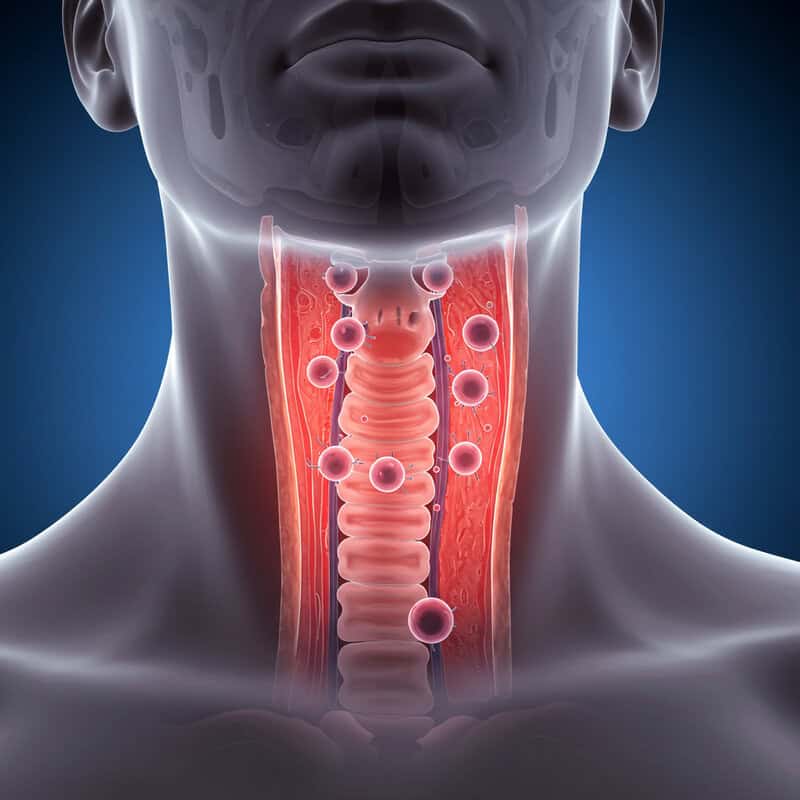
Difficulty swallowing, medically known as dysphagia, can develop if breast cancer metastasizes to the esophagus or nearby structures in the chest. When cancer cells invade or press on the esophagus, they can cause narrowing or obstruction, making it hard to swallow solids or even liquids. This symptom may be accompanied by a sensation of food sticking in the throat, pain during swallowing, or unintentional weight loss due to reduced food intake. In some cases, persistent coughing or hoarseness may also occur as a result of irritation to the esophageal lining or adjacent nerves.
Swallowing difficulties are more commonly caused by benign conditions such as sore throat from viral infections, acid reflux, or temporary irritation from hot or spicy foods. These causes typically resolve within a few days and do not result in significant or progressive swallowing impairment. According to the American Cancer Society, any new, persistent, or worsening difficulty with swallowing should be evaluated by a healthcare provider. Early diagnosis is important for identifying the root cause—including the possibility of metastatic cancer—and for beginning appropriate treatment as soon as possible.
41. Hoarseness or Voice Changes
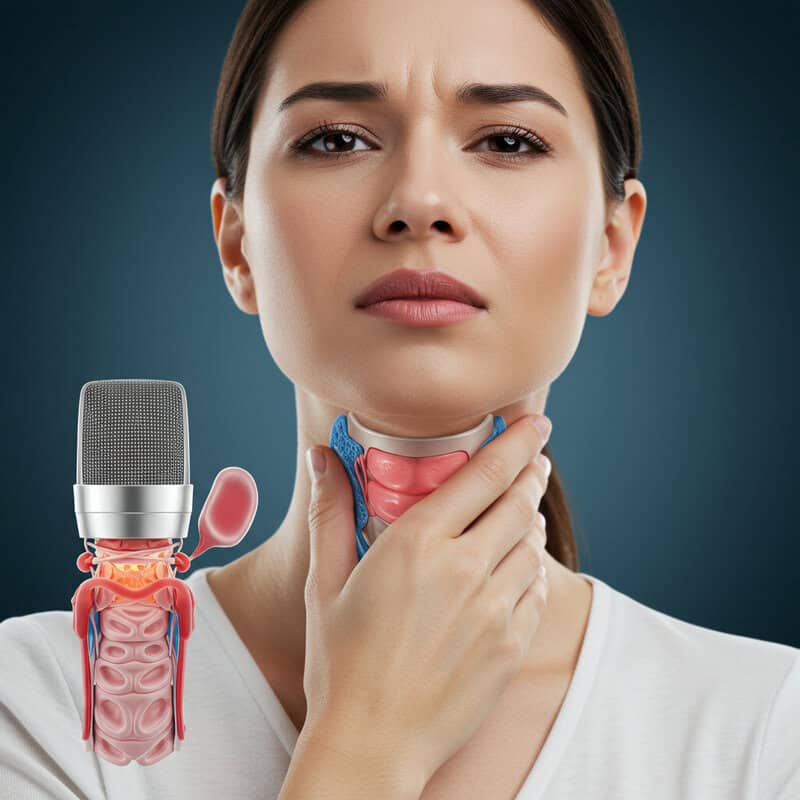
Hoarseness or noticeable changes in the voice can occur if breast cancer spreads to the larynx (voice box), trachea, or nerves controlling the vocal cords. Metastatic cancer in these areas can cause swelling, irritation, or even paralysis of the vocal cords, resulting in a raspy, breathy, or weak voice. Sometimes, hoarseness may be accompanied by difficulty swallowing, persistent cough, or a sensation of a lump in the throat. These symptoms may become progressively worse and do not resolve with typical home remedies.
Most cases of hoarseness are caused by benign conditions such as the common cold, seasonal allergies, or overuse of the voice, and usually resolve within a week or two once the underlying irritation subsides. Temporary voice changes from these causes are rarely associated with other concerning symptoms like weight loss or persistent pain. According to the American Cancer Society, persistent or unexplained hoarseness or voice changes—especially if lasting longer than two weeks or accompanied by other symptoms—should prompt evaluation by a healthcare provider. Early assessment can identify serious causes, including metastatic cancer, and ensure timely intervention.
42. Persistent Nausea or Vomiting
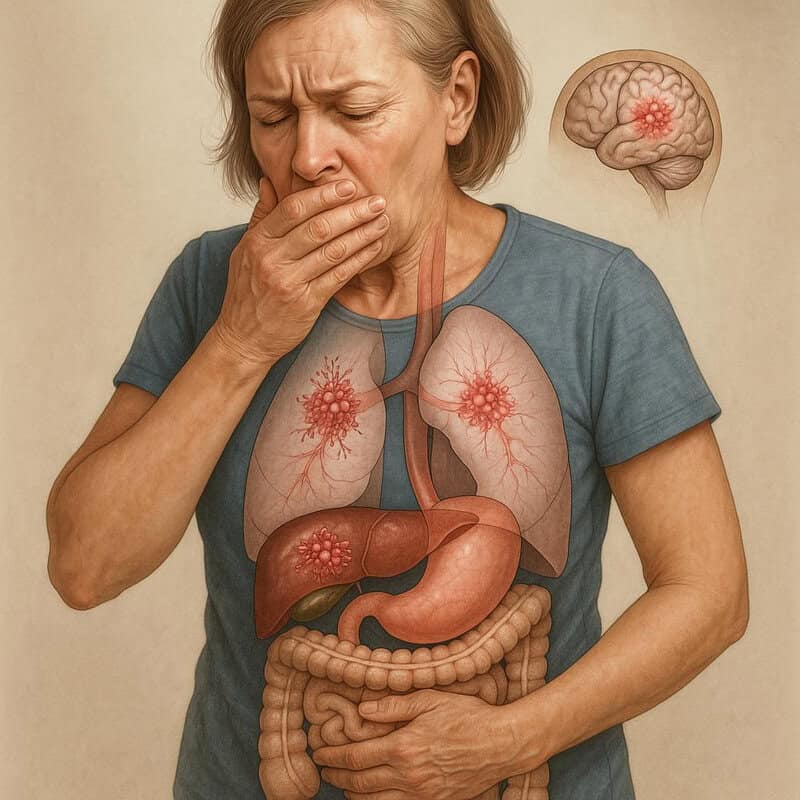
Persistent nausea or vomiting can occur when breast cancer spreads to or affects organs involved in digestion, such as the liver, stomach, or even the brain. Tumor growth can disrupt normal digestive processes, cause blockages, or trigger chemical changes in the body that result in ongoing queasiness or the urge to vomit. In advanced cases, metastasis to the brain may increase intracranial pressure, also leading to these symptoms. Sometimes, nausea and vomiting may be accompanied by decreased appetite, weight loss, or abdominal discomfort.
Most episodes of nausea or vomiting are caused by benign conditions like viral gastroenteritis (“stomach flu”), food poisoning, or side effects of medications. These common causes are usually short-lived, resolve within a few days, and are often accompanied by other typical symptoms such as diarrhea or fever. According to the American Cancer Society, persistent or unexplained nausea and vomiting—especially if lasting more than a few days, associated with other concerning symptoms, or not related to an obvious illness—should be evaluated by a healthcare provider. Timely assessment helps identify underlying causes, including possible cancer, and ensures prompt treatment.
43. Unusual Vaginal Bleeding (in Rare Cases)

Unusual vaginal bleeding can occasionally occur in rare cases of breast cancer due to hormonal changes or, less commonly, metastasis to reproductive organs. Some breast cancers, particularly those that are hormone receptor-positive, can disrupt the body’s normal hormonal balance and lead to irregular uterine bleeding. In extremely rare situations, metastatic breast cancer may spread to the uterus or ovaries, resulting in abnormal bleeding patterns. This symptom may present as bleeding between menstrual periods, after menopause, or as unusually heavy or prolonged periods.
Most episodes of vaginal bleeding are related to benign causes such as hormonal fluctuations, changes in birth control, stress, or the onset of menopause. Menstrual cycles may naturally vary from month to month, and occasional spotting is common for many women. However, according to the American Cancer Society, any unexplained, persistent, or unusually heavy vaginal bleeding—especially if it occurs after menopause or outside the normal cycle—should be promptly reported to a healthcare provider. Timely evaluation is crucial for identifying the underlying cause and ruling out serious conditions, including the rare possibility of metastatic breast cancer.
44. Persistent Indigestion or Heartburn
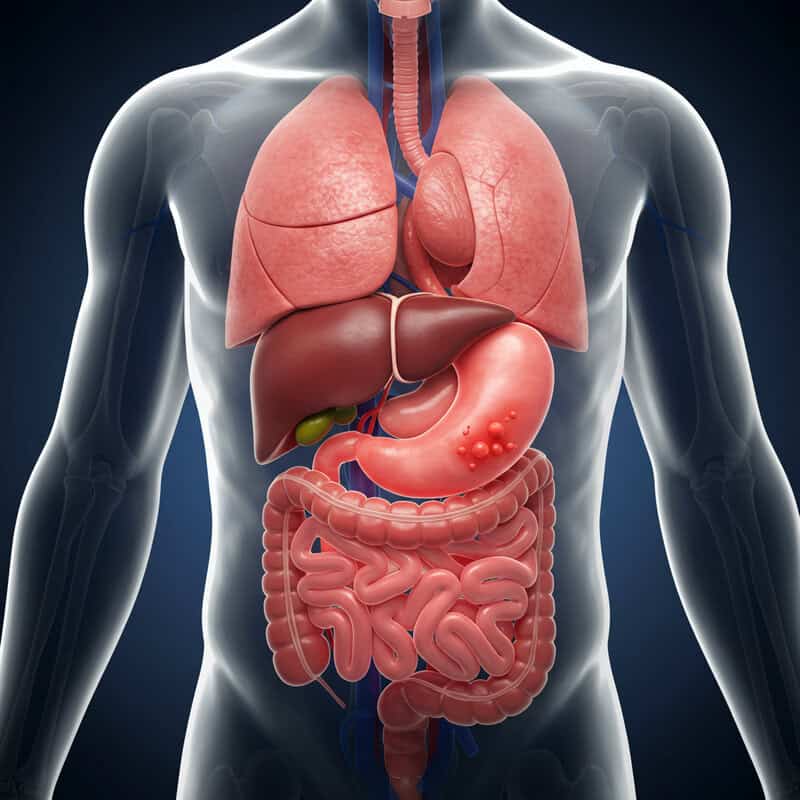
Persistent indigestion or heartburn can sometimes be a sign of breast cancer that has spread to the digestive tract or nearby organs. Tumors pressing on the stomach, esophagus, or liver may disrupt normal digestion, leading to ongoing discomfort, burning sensations, or bloating that do not improve with standard remedies. These symptoms may be accompanied by nausea, loss of appetite, or unexplained weight loss, especially in advanced stages of disease. The presence of persistent digestive symptoms, particularly when combined with other warning signs, should raise concern for an underlying systemic issue.
Most cases of indigestion or heartburn are due to benign causes, such as overeating, spicy foods, stress, or mild acid reflux. These episodes are generally temporary, improve with dietary adjustments or over-the-counter medications, and are not linked to other serious symptoms. According to the American Cancer Society, any persistent or unexplained digestive symptoms—especially if they are new, worsening, or associated with other symptoms such as pain or weight loss—should be evaluated by a healthcare provider. Early assessment is essential to identify the underlying cause and ensure appropriate management, including the possibility of metastatic cancer.
45. Persistent Hiccups

Persistent hiccups can be a rare but noteworthy symptom of advanced breast cancer, especially if the cancer irritates the nerves controlling the diaphragm, such as the phrenic or vagus nerves. Tumors affecting the chest, lungs, or upper abdomen may exert pressure on these nerves, resulting in continual or recurrent hiccups that last for days or even weeks. In some cases, persistent hiccups may also signal the spread of cancer to the brain or liver, where irritation of nerve centers involved in the hiccup reflex can occur.
Most episodes of hiccups are benign and short-lived, often triggered by eating too quickly, drinking carbonated beverages, or sudden temperature changes. These transient hiccups typically resolve on their own within a few minutes to hours and are not associated with other symptoms. According to the American Cancer Society, hiccups lasting longer than 48 hours or occurring alongside other unexplained symptoms should be checked by a healthcare provider. Persistent hiccups may indicate a more serious underlying issue, including nerve irritation from cancer, and warrant timely evaluation to determine the cause and guide appropriate treatment.
46. Nipple Crusting

Nipple crusting occurs when dried fluid, blood, or pus forms a hard layer on the surface of the nipple, often as a result of underlying disease processes such as breast cancer. Certain types of cancer—including Paget’s disease of the nipple—can cause abnormal discharge and skin irritation, leading to persistent crusting, scaling, or the formation of a scab-like texture on the nipple or areola. This condition is often accompanied by redness, itching, or changes in nipple shape, and may not resolve with routine skin care.
Crusting can also result from benign causes such as friction from tight clothing, improper breastfeeding technique, or mild skin irritation. In these cases, the crusting is usually mild, temporary, and improves with adjustments in habits or use of moisturizers. However, as noted by the American Cancer Society, nipple crusting that persists, recurs, or is associated with other symptoms like discharge, pain, or changes in skin texture should prompt evaluation by a healthcare provider. Early assessment is essential to determine the underlying cause and to ensure timely treatment if breast cancer or another serious condition is present.
47. Nipple Erosion
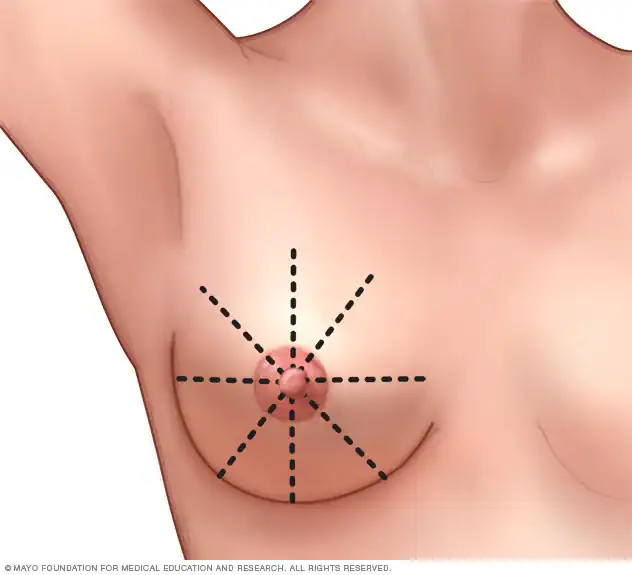
Nipple erosion occurs when the surface tissue of the nipple breaks down, leading to areas of rawness, open sores, or loss of the normal skin layer. This can be a result of tumor invasion, where cancer cells disrupt the skin’s integrity and prevent normal healing. Over time, the affected area may become increasingly painful, ooze fluid or blood, and resist standard wound care. Nipple erosion is often seen in more advanced cases of breast cancer, such as Paget’s disease, and can signal underlying malignancy within the breast or ductal system.
Minor abrasions or superficial wounds to the nipple are usually caused by friction, breastfeeding challenges, or accidental injury. These benign injuries tend to be shallow, heal within days to a couple of weeks, and do not recur in the same location. According to the American Cancer Society, any persistent or worsening nipple erosion, especially if associated with other symptoms like discharge, crusting, or skin changes, should prompt immediate evaluation by a healthcare provider. Timely diagnosis is crucial for initiating appropriate treatment and improving outcomes if cancer is present.
48. Nipple Flattening
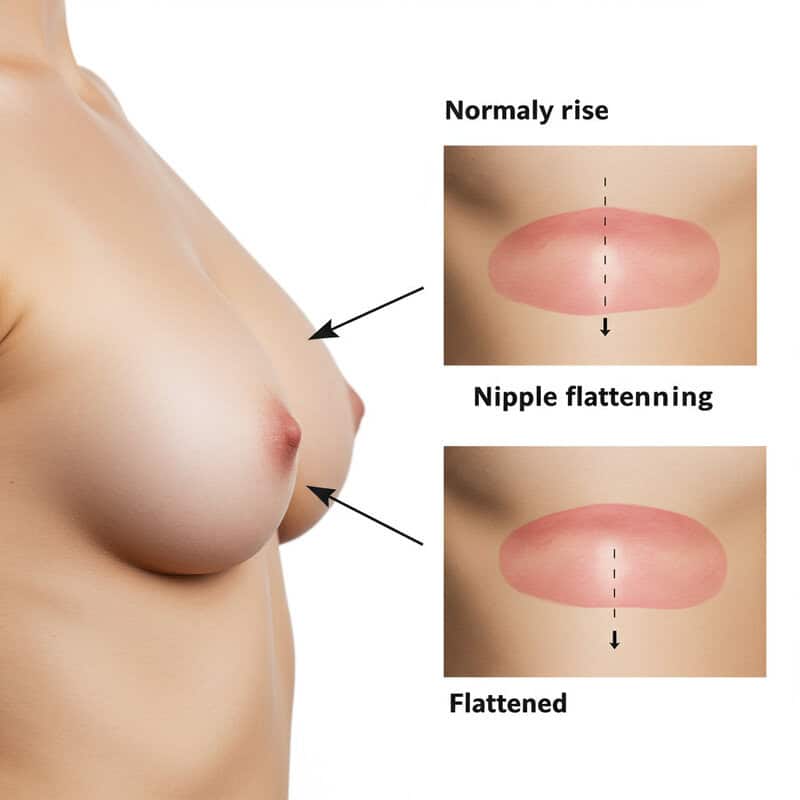
Nipple flattening occurs when the normally raised or protruding nipple becomes less prominent or appears pressed in, often as a result of tissue infiltration by abnormal cells or tumors. As breast cancer develops, it can invade and disrupt the connective tissue and ducts beneath the nipple, causing the nipple to lose its typical shape and projection. This change may be subtle at first but can become more noticeable over time, particularly if accompanied by other symptoms such as skin changes, discharge, or a palpable lump beneath the nipple.
It is important to differentiate nipple flattening due to cancer from variations in nipple shape that are normal for some individuals. Some people naturally have flat or slightly inverted nipples from birth, and these characteristics generally do not change suddenly or are not associated with pain or other breast changes. According to the American Cancer Society, any new, persistent, or progressive flattening of the nipple—especially if it is unilateral and accompanied by other concerning symptoms—should be evaluated by a healthcare provider. Early medical assessment is crucial for identifying underlying causes and determining the need for further investigation or treatment.
49. Pain in the Upper Back, Shoulder, or Neck
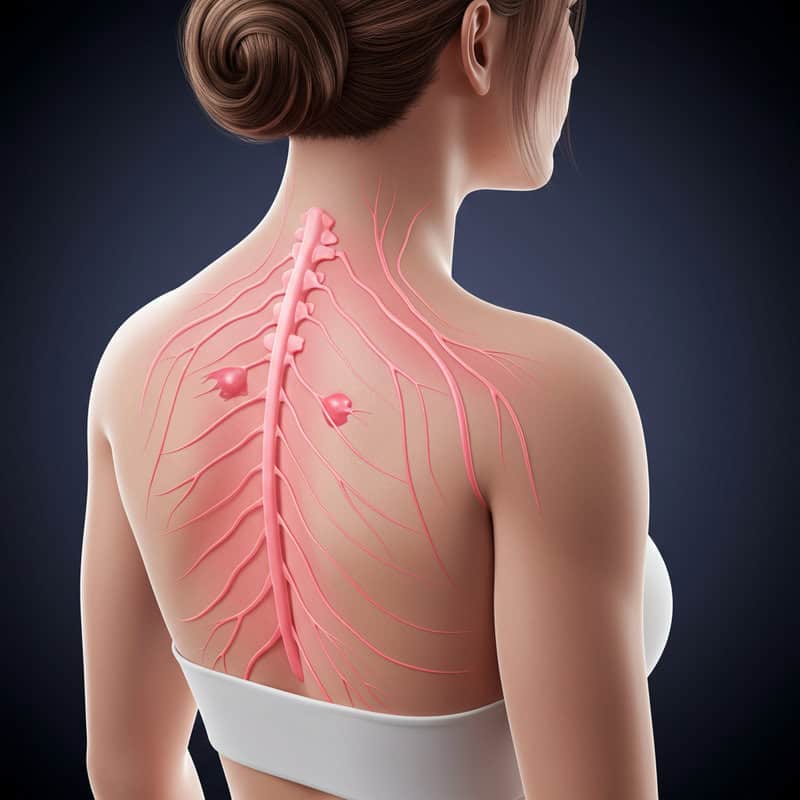
Pain in the upper back, shoulder, or neck can sometimes be a sign of referred pain from breast cancer or metastatic disease. Tumors in the breast, especially those located near the chest wall, may irritate nerves that radiate to these regions, leading to persistent aches or discomfort. Additionally, if breast cancer spreads (metastasizes) to the bones or soft tissues of the spine, shoulders, or neck, it can cause deep, unrelenting pain that often worsens over time and does not respond to typical pain relief methods. This pain may be accompanied by other symptoms such as weakness, numbness, or limited range of motion.
Most pain in these areas is related to musculoskeletal causes, such as muscle strain, poor posture, or tension, which are generally temporary and improve with rest, stretching, or over-the-counter medications. However, according to the American Cancer Society, persistent or unexplained pain in the upper back, shoulder, or neck—especially when not linked to an obvious injury or when associated with other breast symptoms—should be evaluated by a healthcare provider. Timely assessment is important for ruling out serious underlying causes, including breast cancer.
50. General Feeling of Being Unwell

A general feeling of being unwell, or malaise, can sometimes be an early or ongoing sign of breast cancer or other systemic illnesses. Malaise is characterized by a vague sense of discomfort, fatigue, or lack of well-being that is difficult to attribute to a specific cause. As breast cancer progresses or spreads, it can produce subtle, whole-body symptoms, including low-grade fever, persistent tiredness, muscle aches, and a reduced ability to carry out routine activities. These symptoms may develop gradually and linger, sometimes even before more obvious signs of cancer appear.
Most people experience periods of feeling unwell due to common causes like colds, viral infections, or stress. These episodes are usually short-lived, resolve with rest, and are accompanied by more specific symptoms such as sore throat, cough, or congestion. According to the American Cancer Society, persistent or unexplained malaise—especially if it is accompanied by other warning signs like weight loss, pain, or changes in the breast—should prompt evaluation by a healthcare provider. Early assessment can help identify the underlying cause and ensure timely treatment, particularly if a systemic illness such as cancer is responsible.
Conclusion
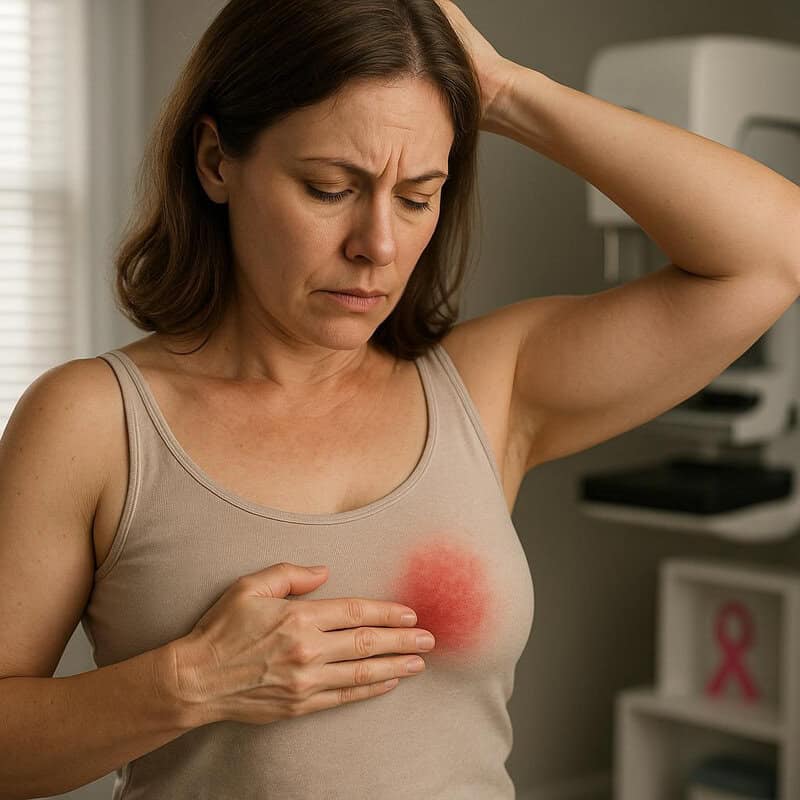
Recognizing the early and varied signs of breast cancer is critical to improving outcomes and saving lives. If you notice any persistent changes in your breasts, it is essential to act promptly and consult a healthcare provider for further evaluation. Regular self-exams, staying aware of your body, and scheduling routine screening mammograms are practical steps for early detection. Early intervention can make a significant difference in treatment success. For more information about breast cancer symptoms and screening, visit the American Cancer Society or Breastcancer.org.
Disclaimer
The information provided in this article is for general informational purposes only. While we strive to keep the information up-to-date and correct, we make no representations or warranties of any kind, express or implied, about the completeness, accuracy, reliability, suitability, or availability with respect to the article or the information, products, services, or related graphics contained in the article for any purpose. Any reliance you place on such information is therefore strictly at your own risk.
In no event will we be liable for any loss or damage including without limitation, indirect or consequential loss or damage, or any loss or damage whatsoever arising from loss of data or profits arising out of, or in connection with, the use of this article.
Through this article you are able to link to other websites which are not under our control. We have no control over the nature, content, and availability of those sites. The inclusion of any links does not necessarily imply a recommendation or endorse the views expressed within them.
Every effort is made to keep the article up and running smoothly. However, we take no responsibility for, and will not be liable for, the article being temporarily unavailable due to technical issues beyond our control.





